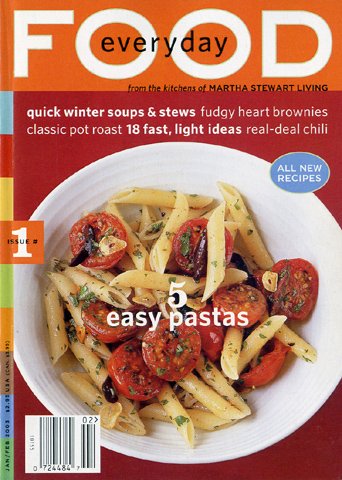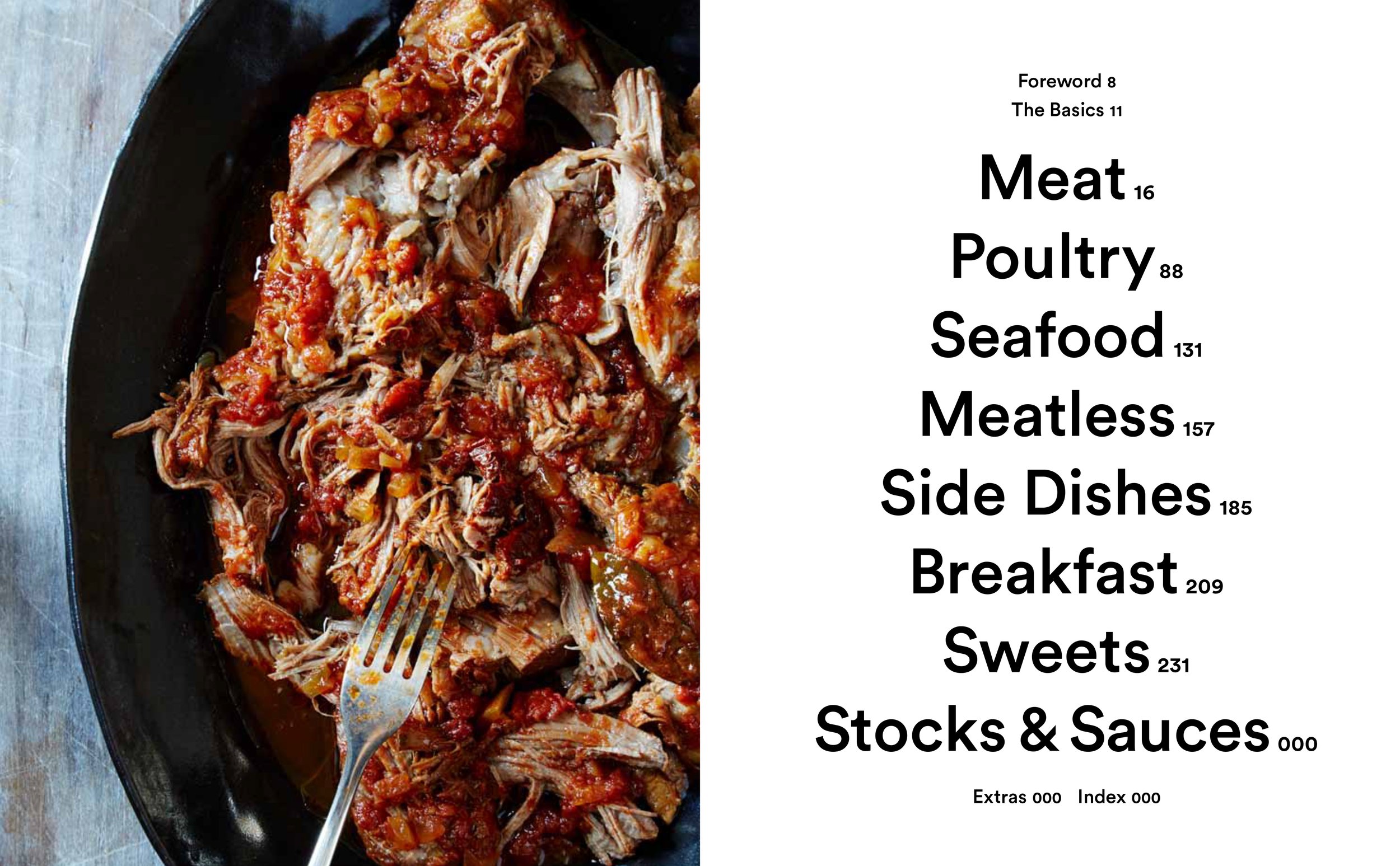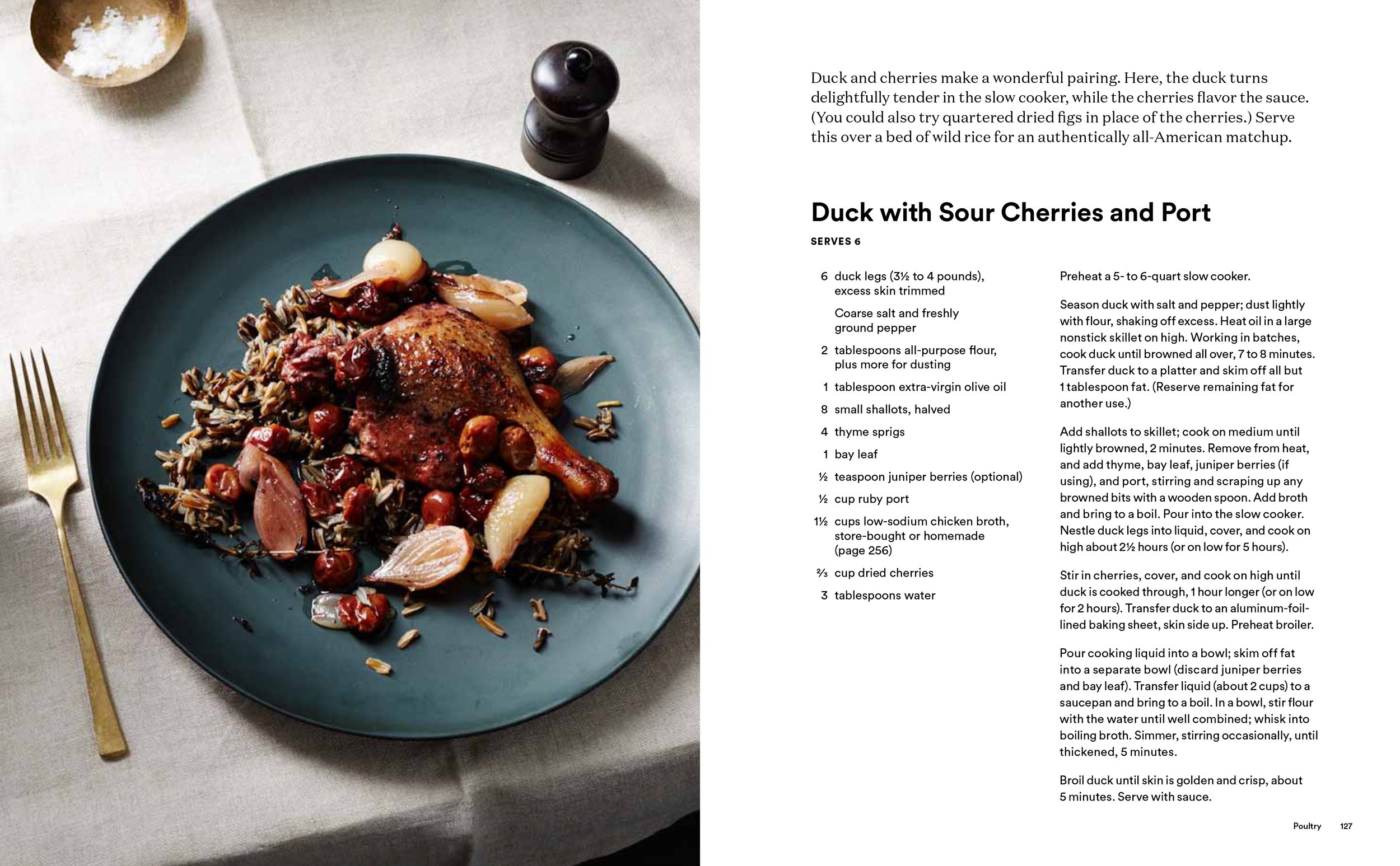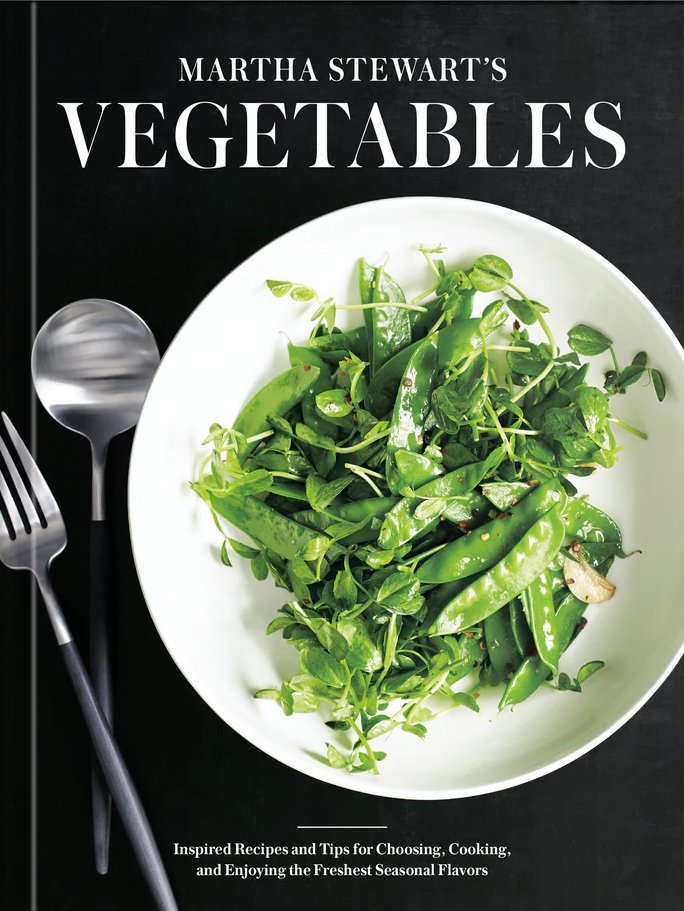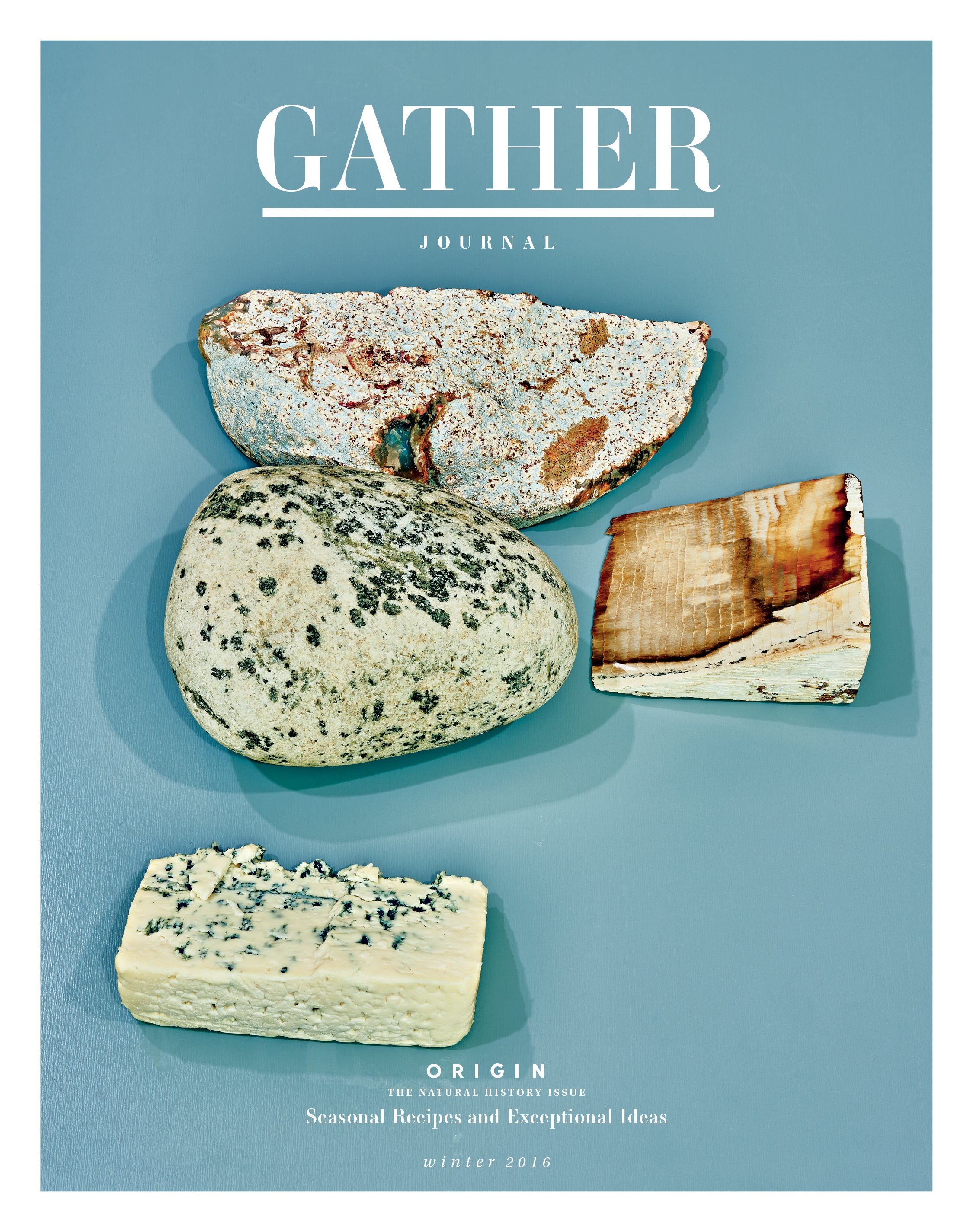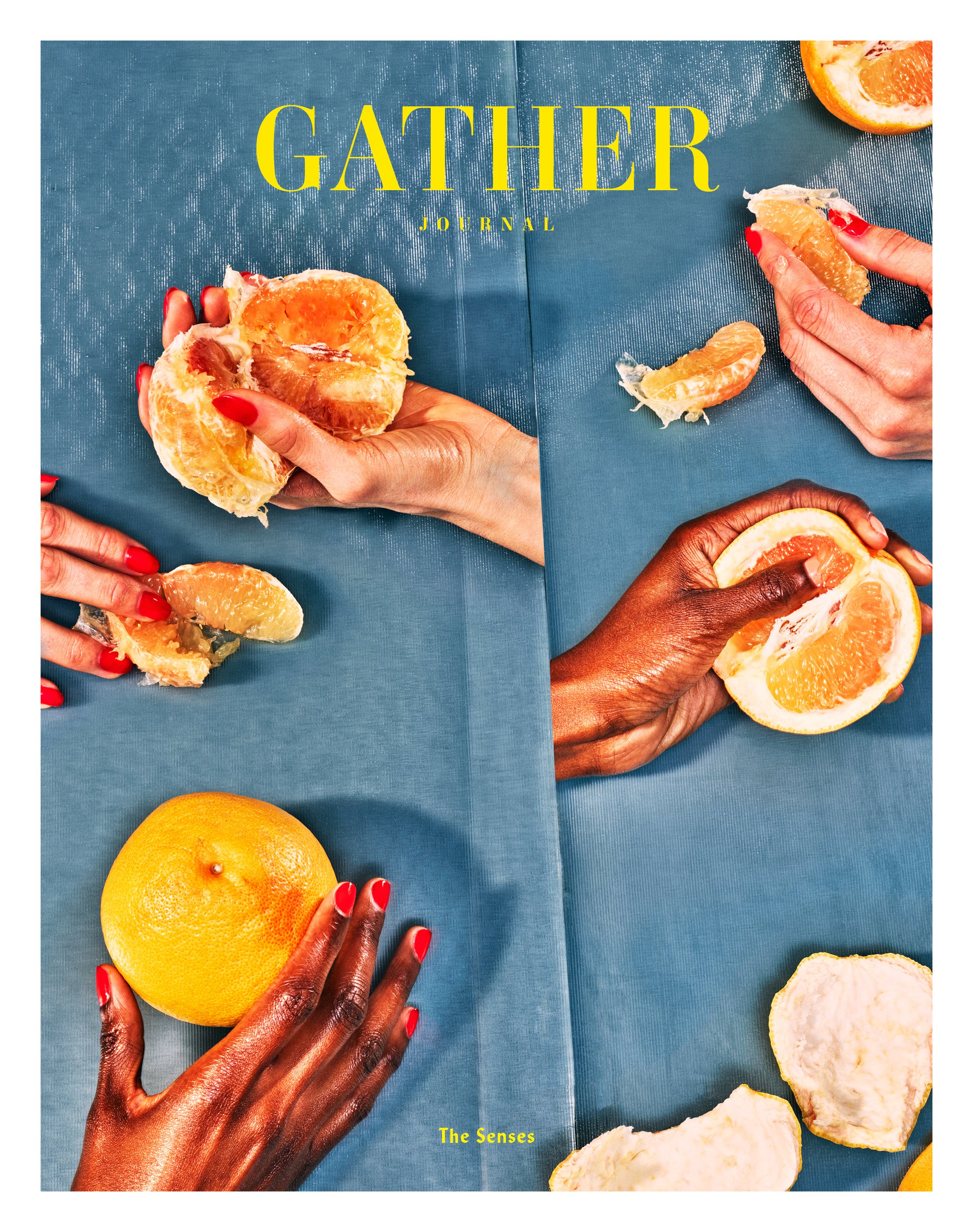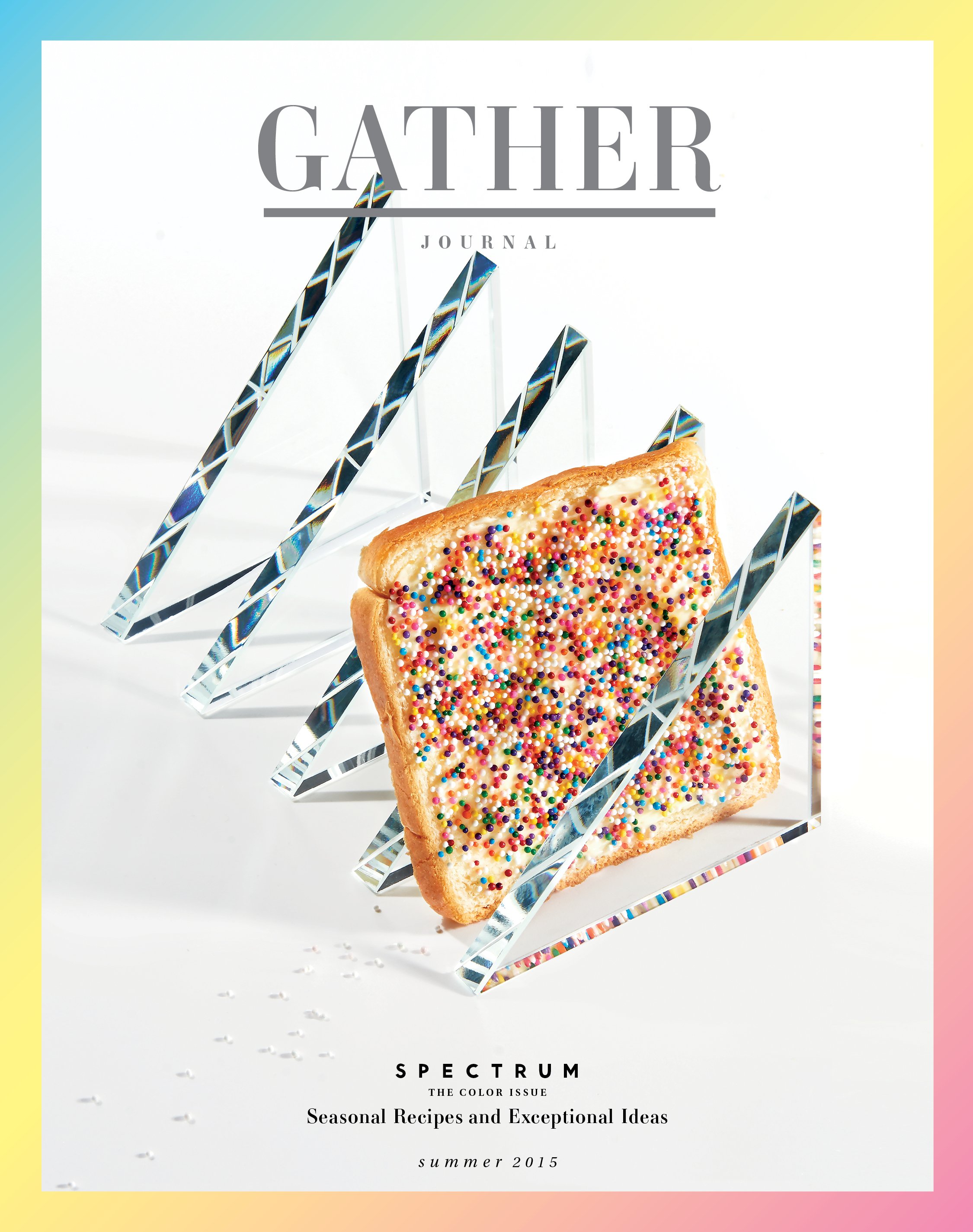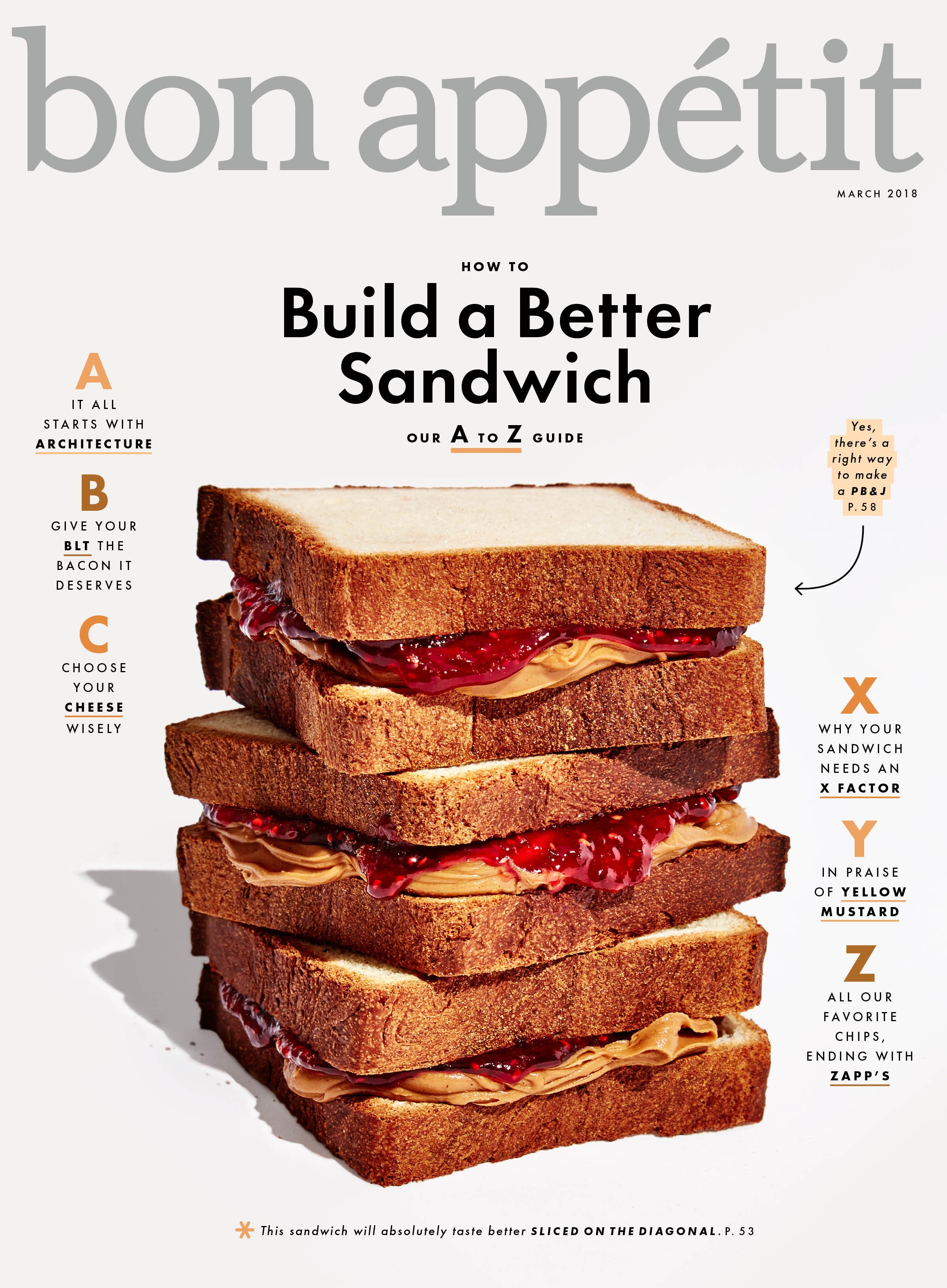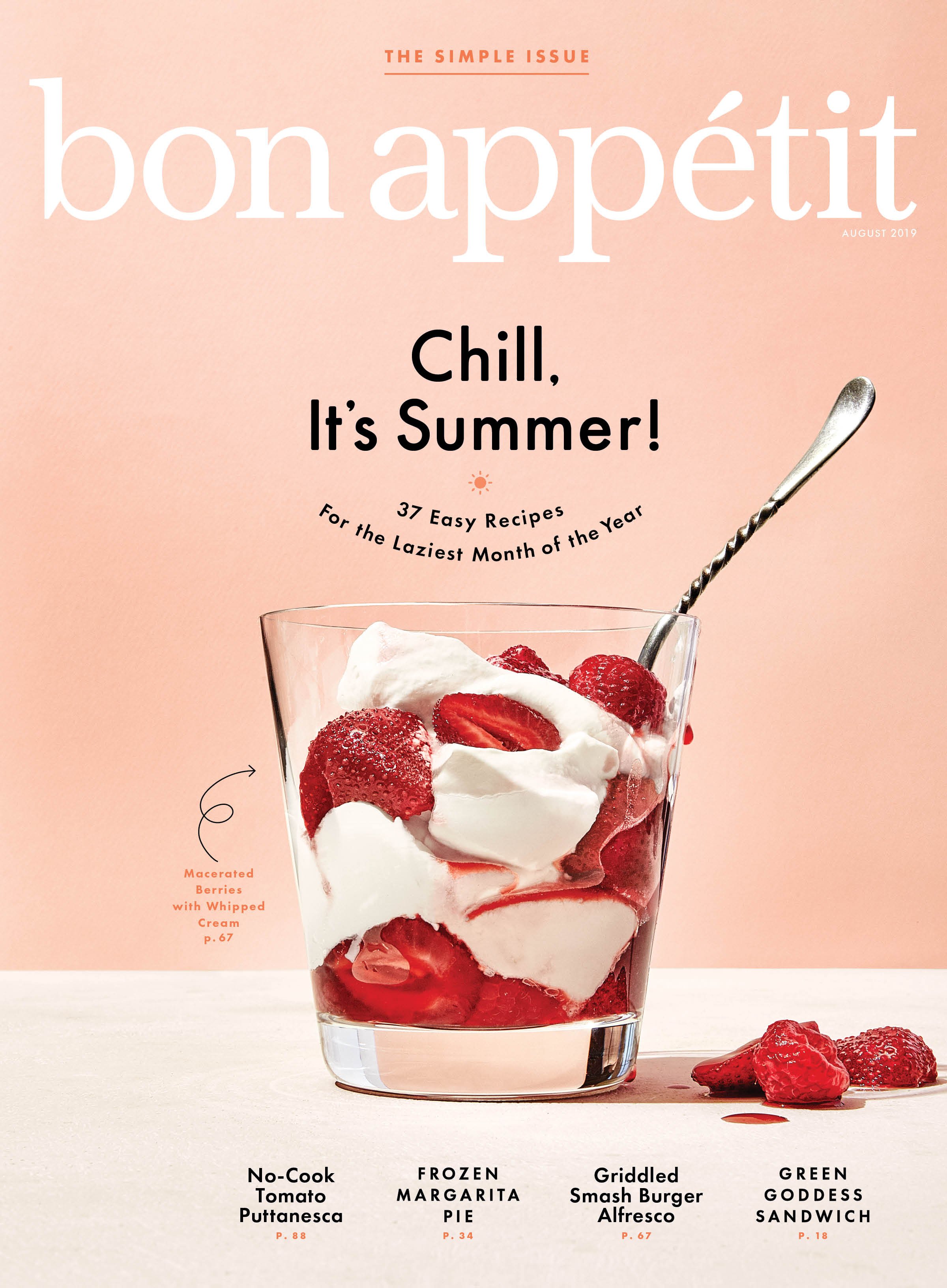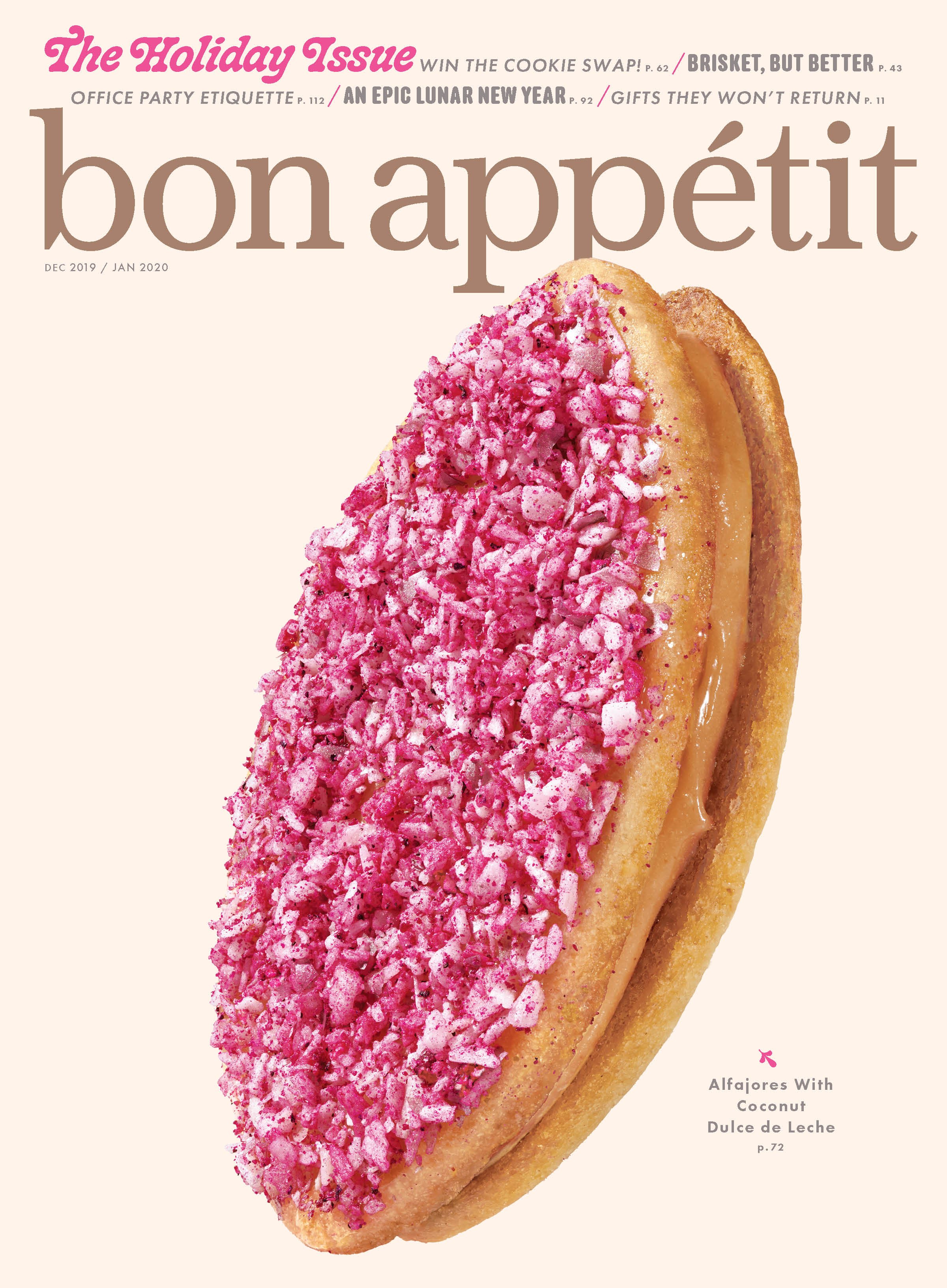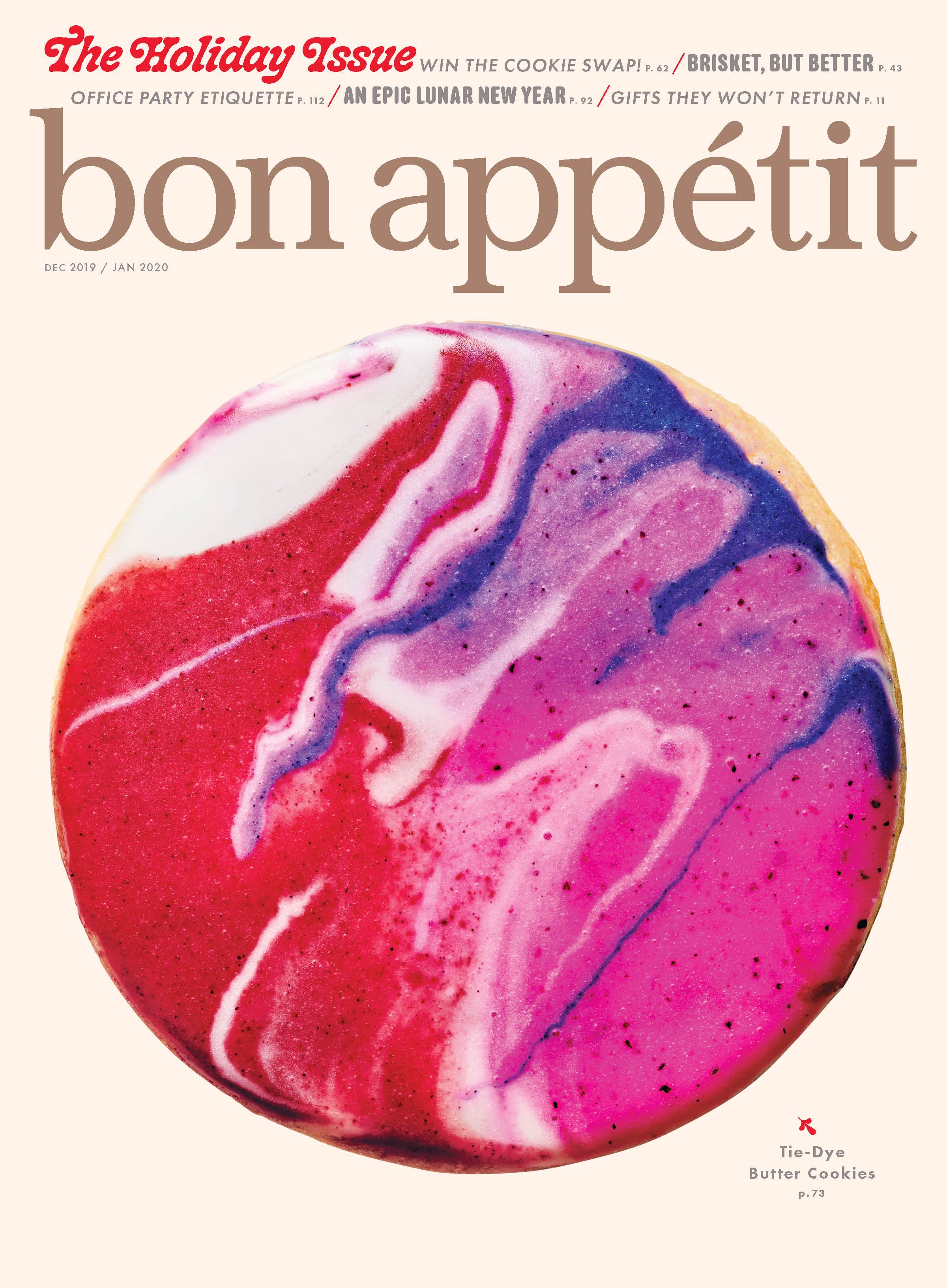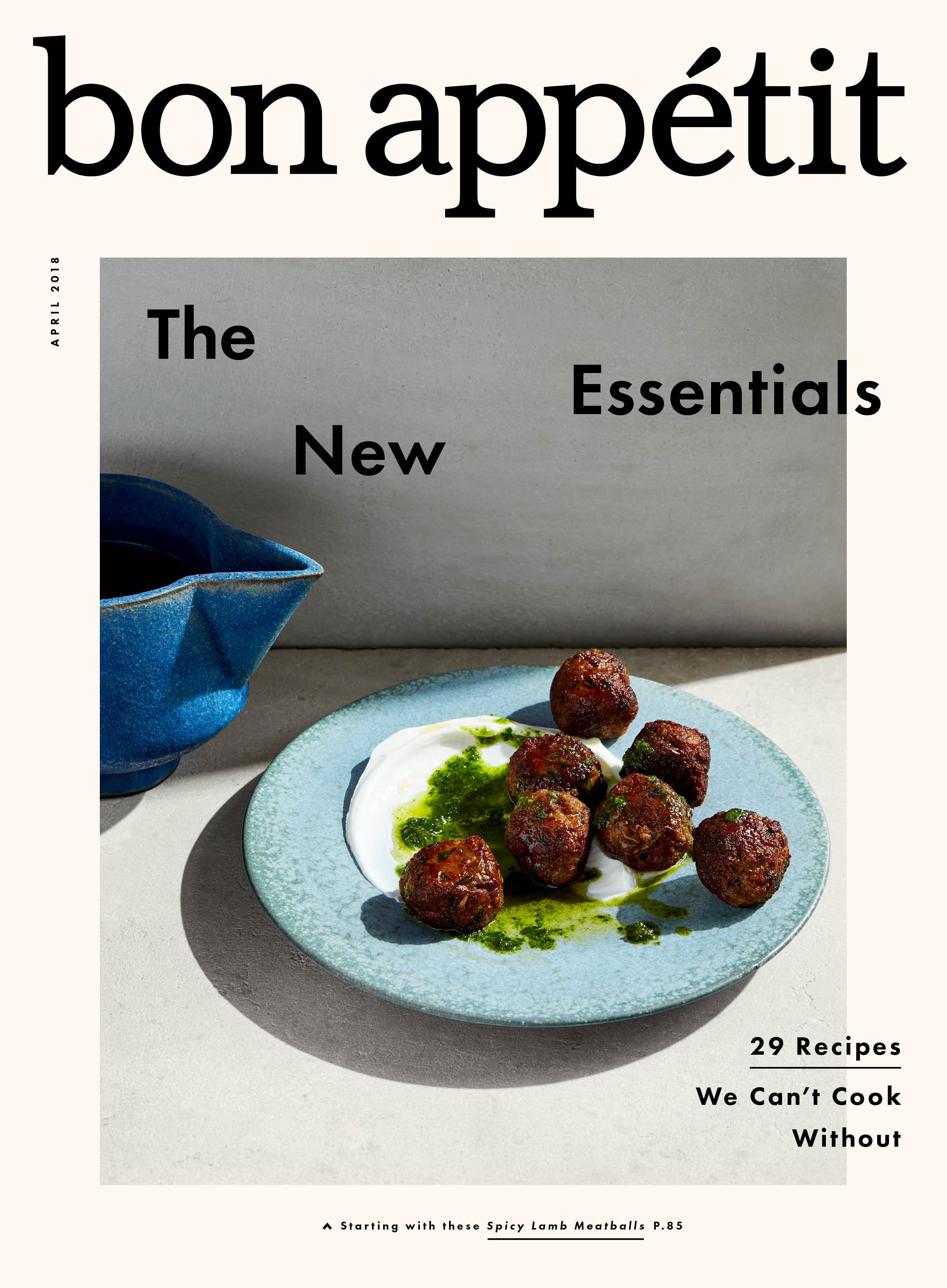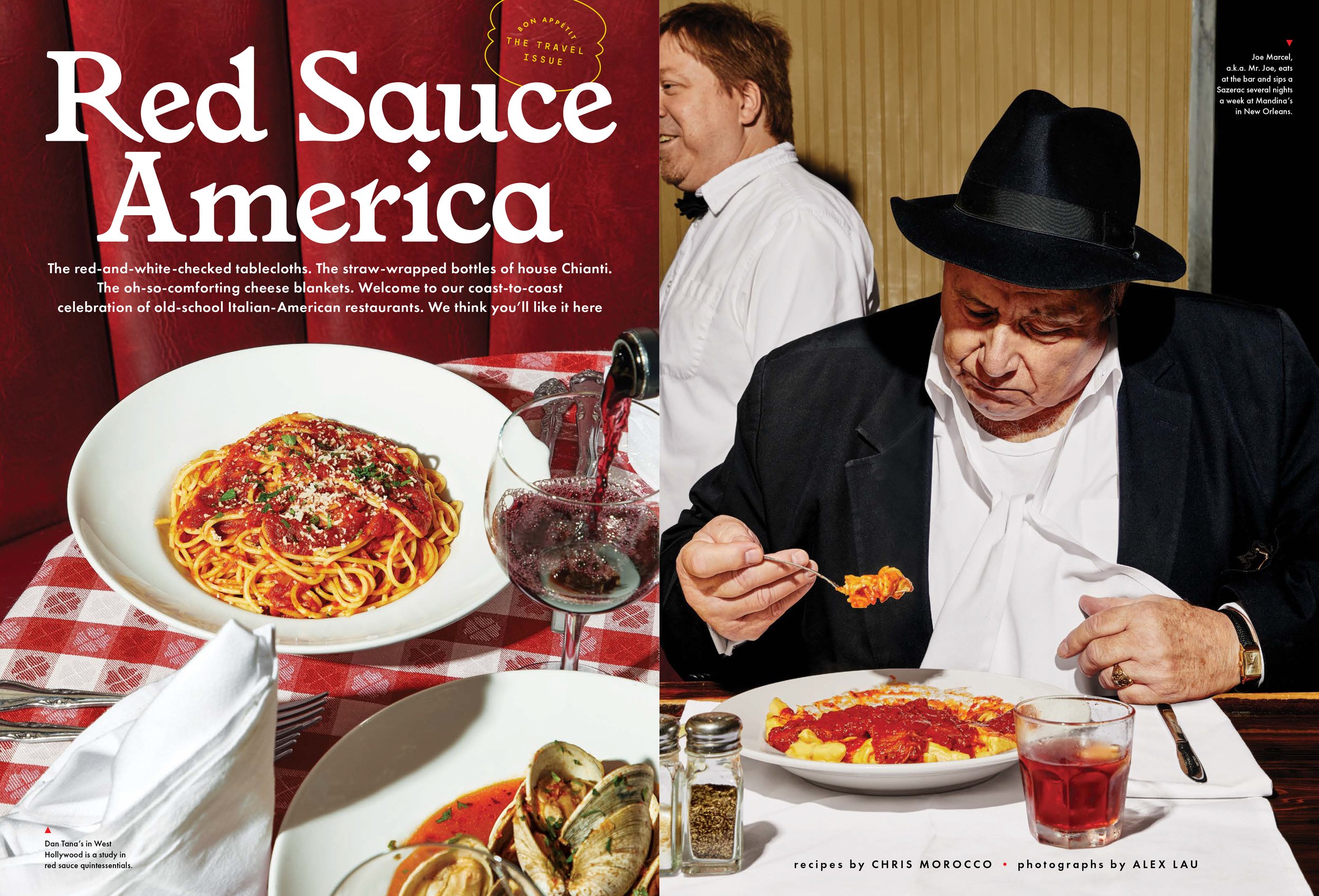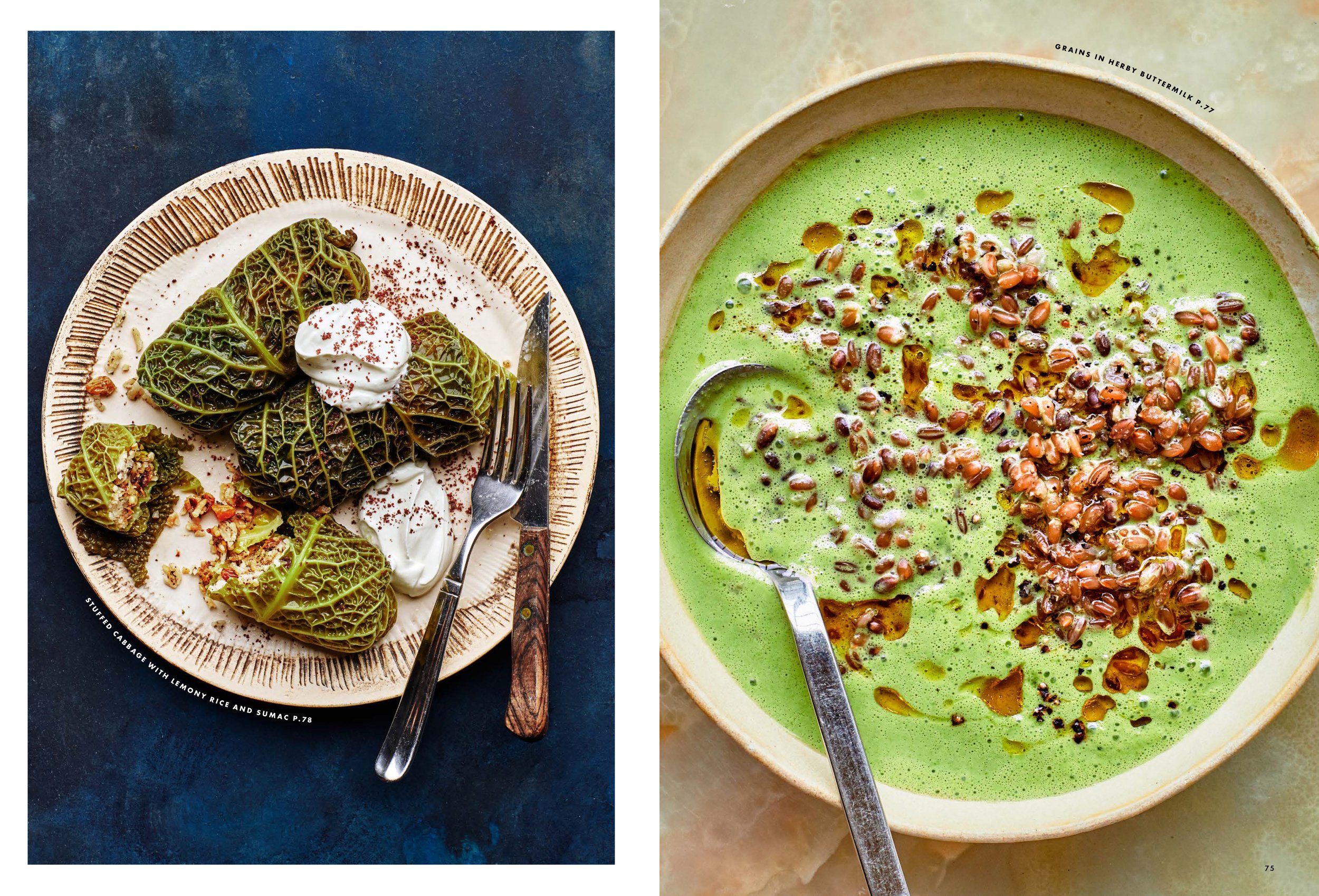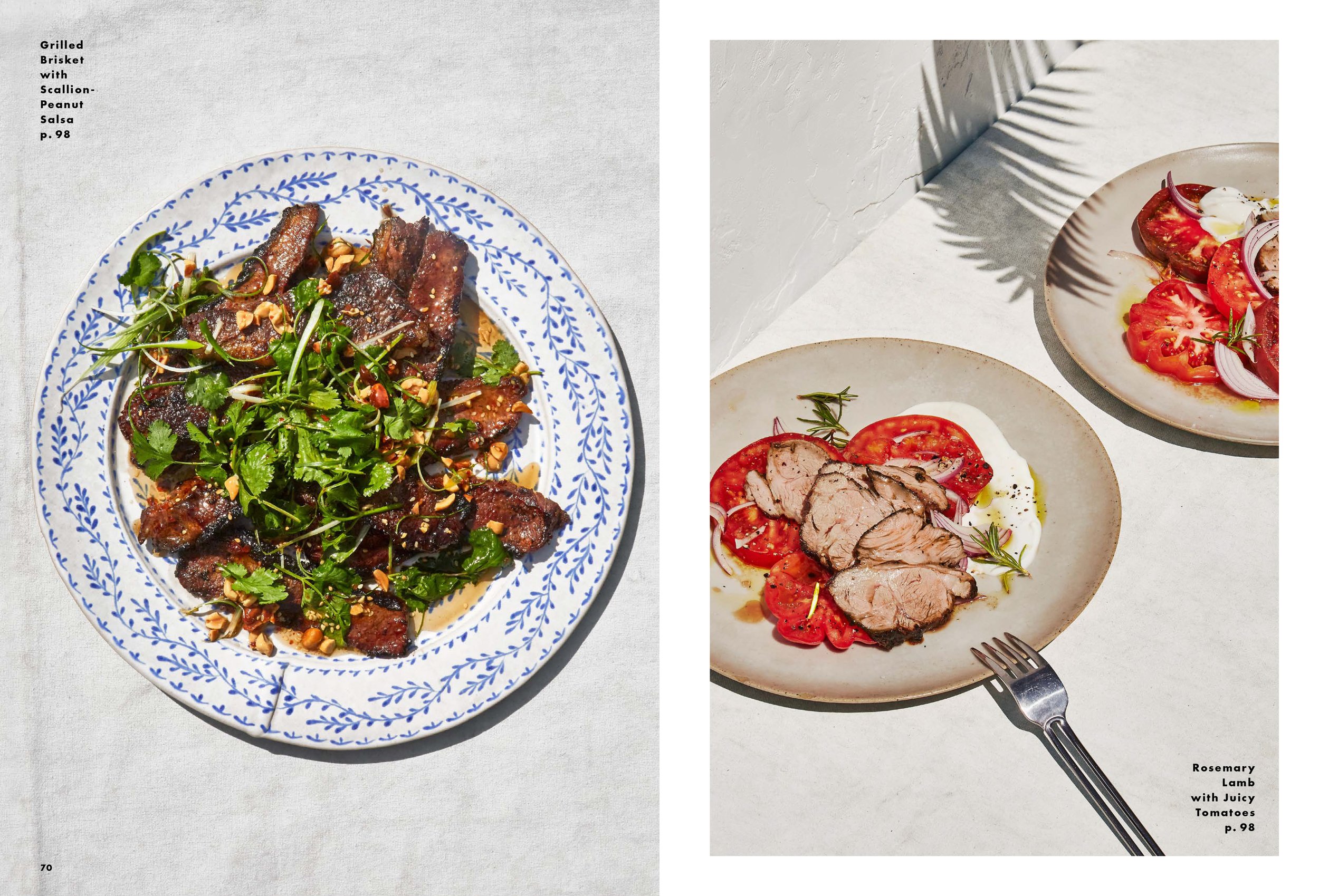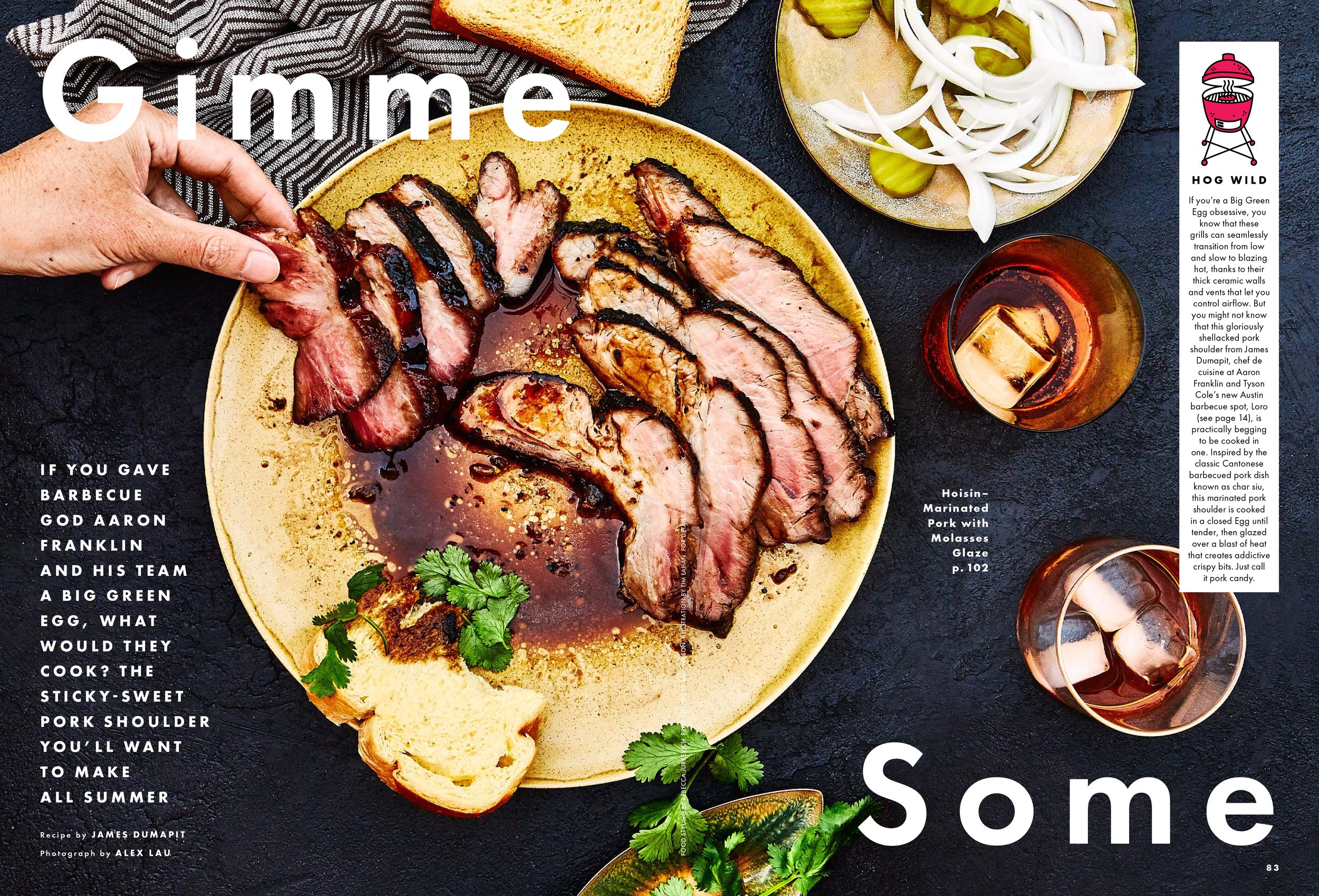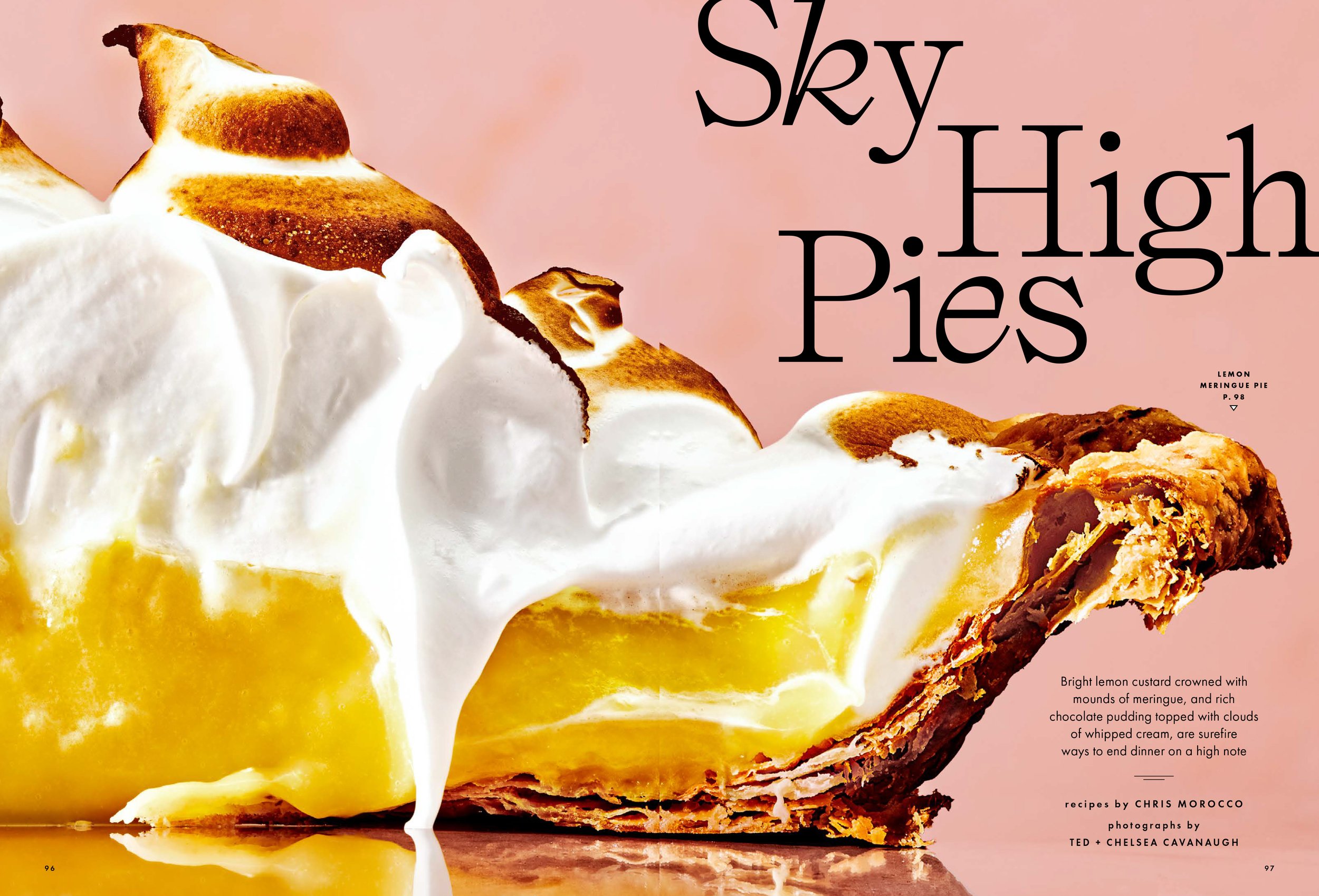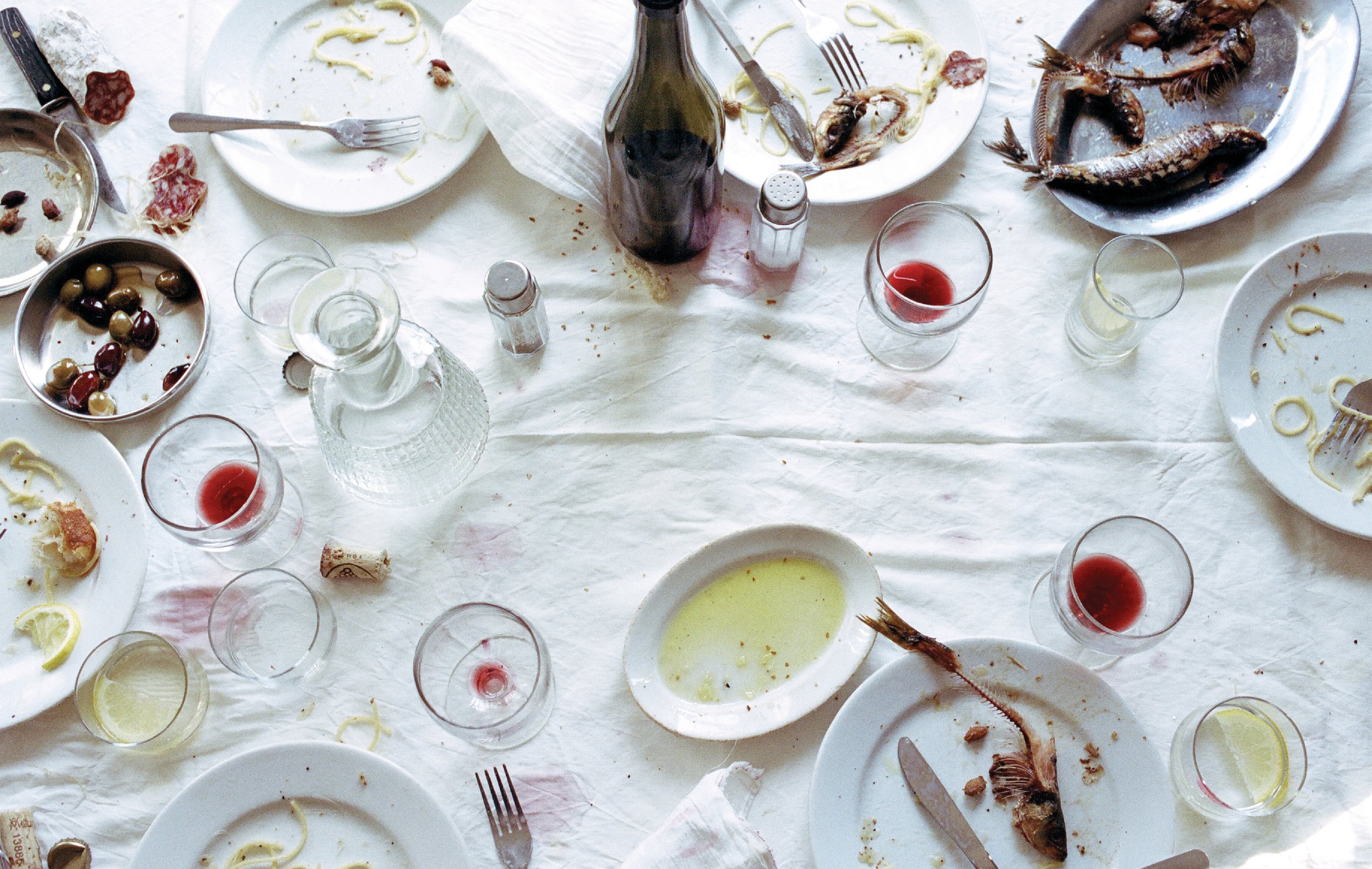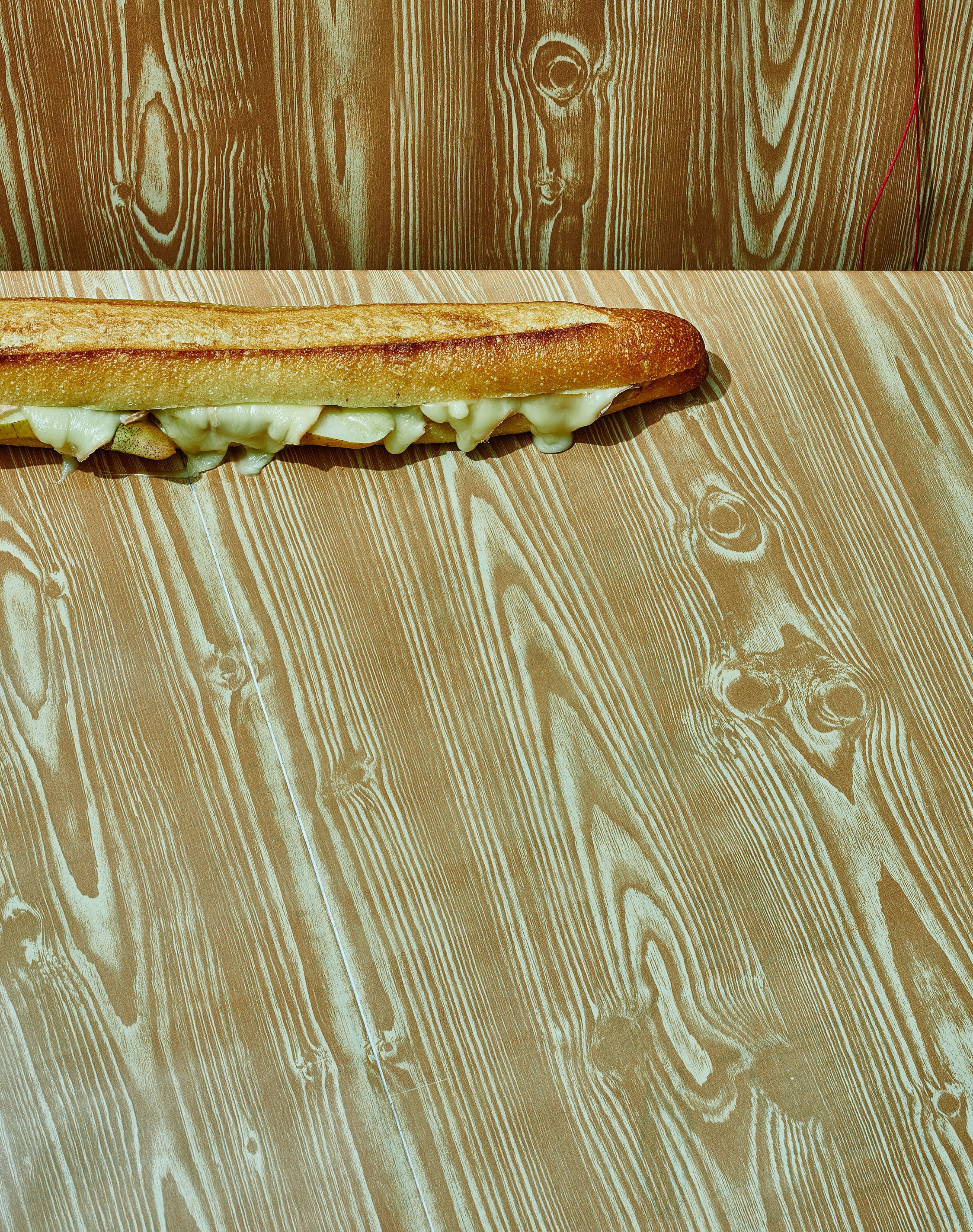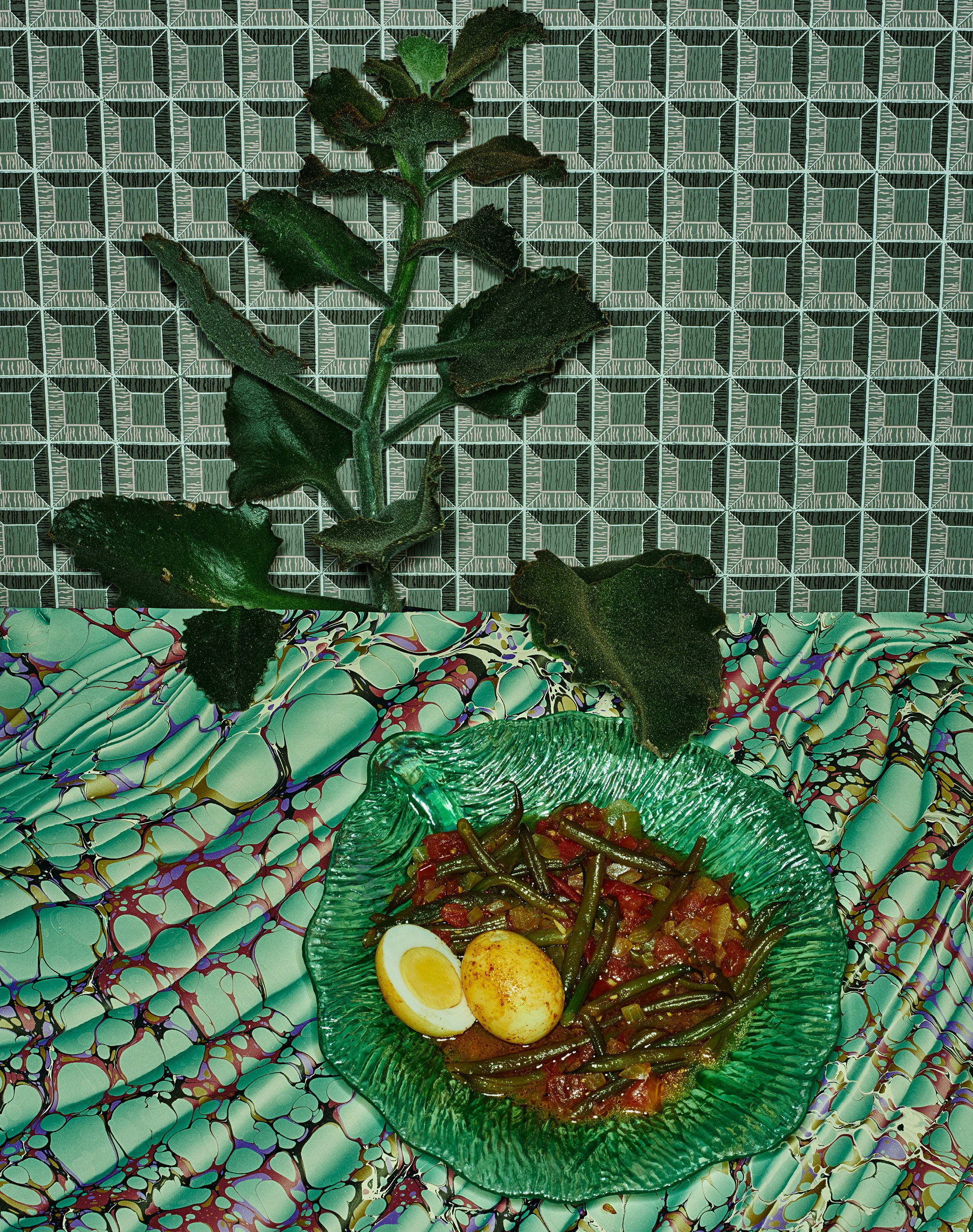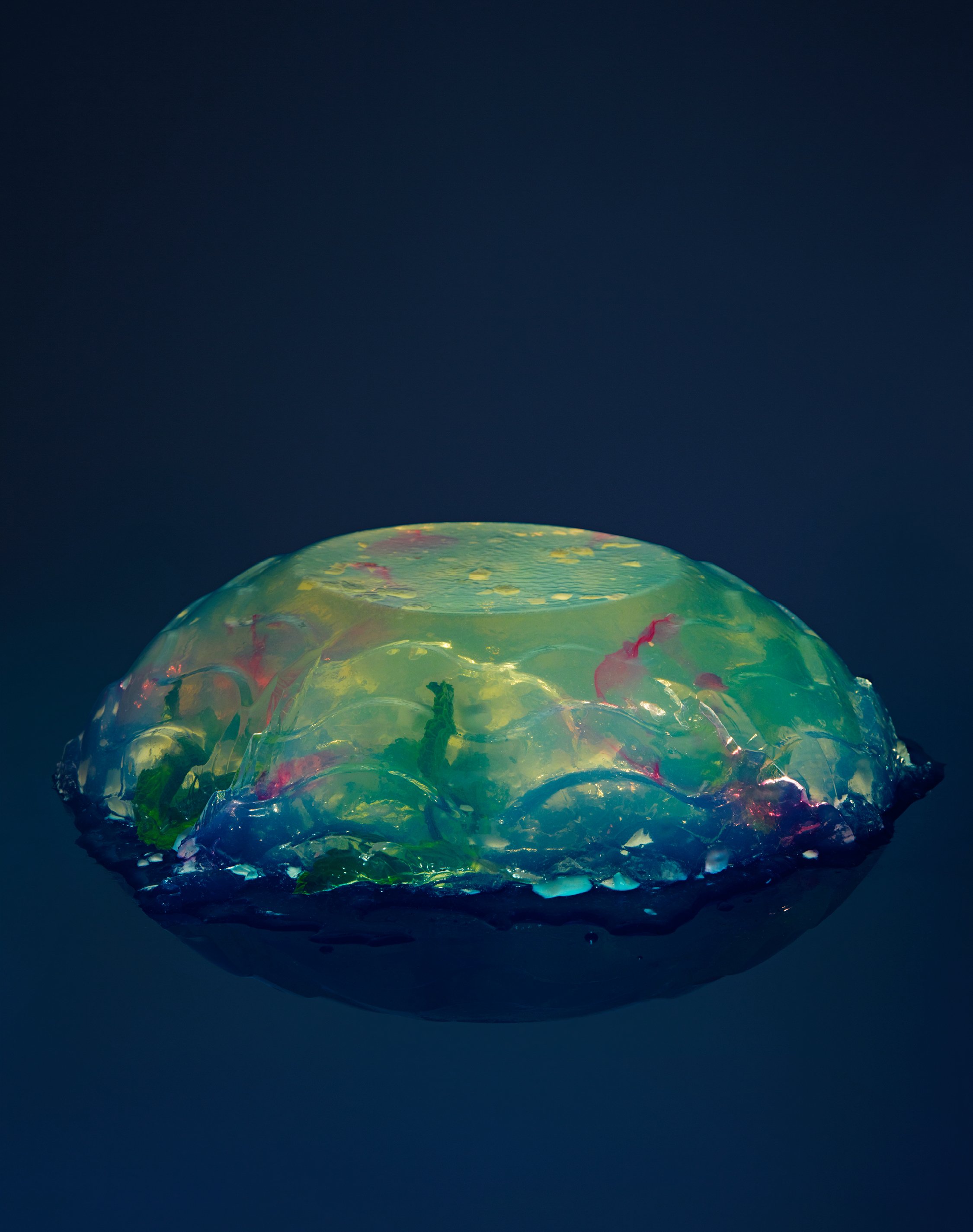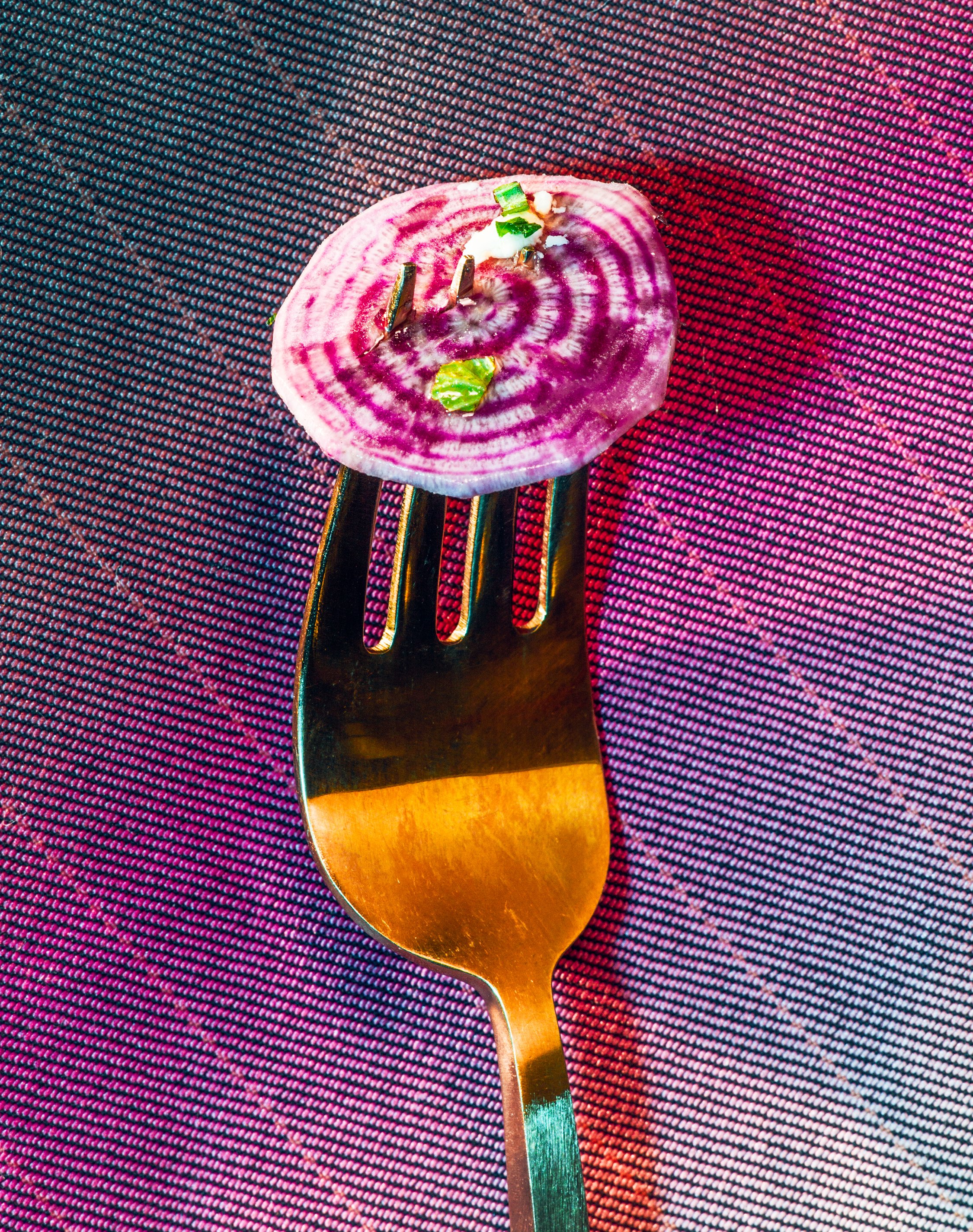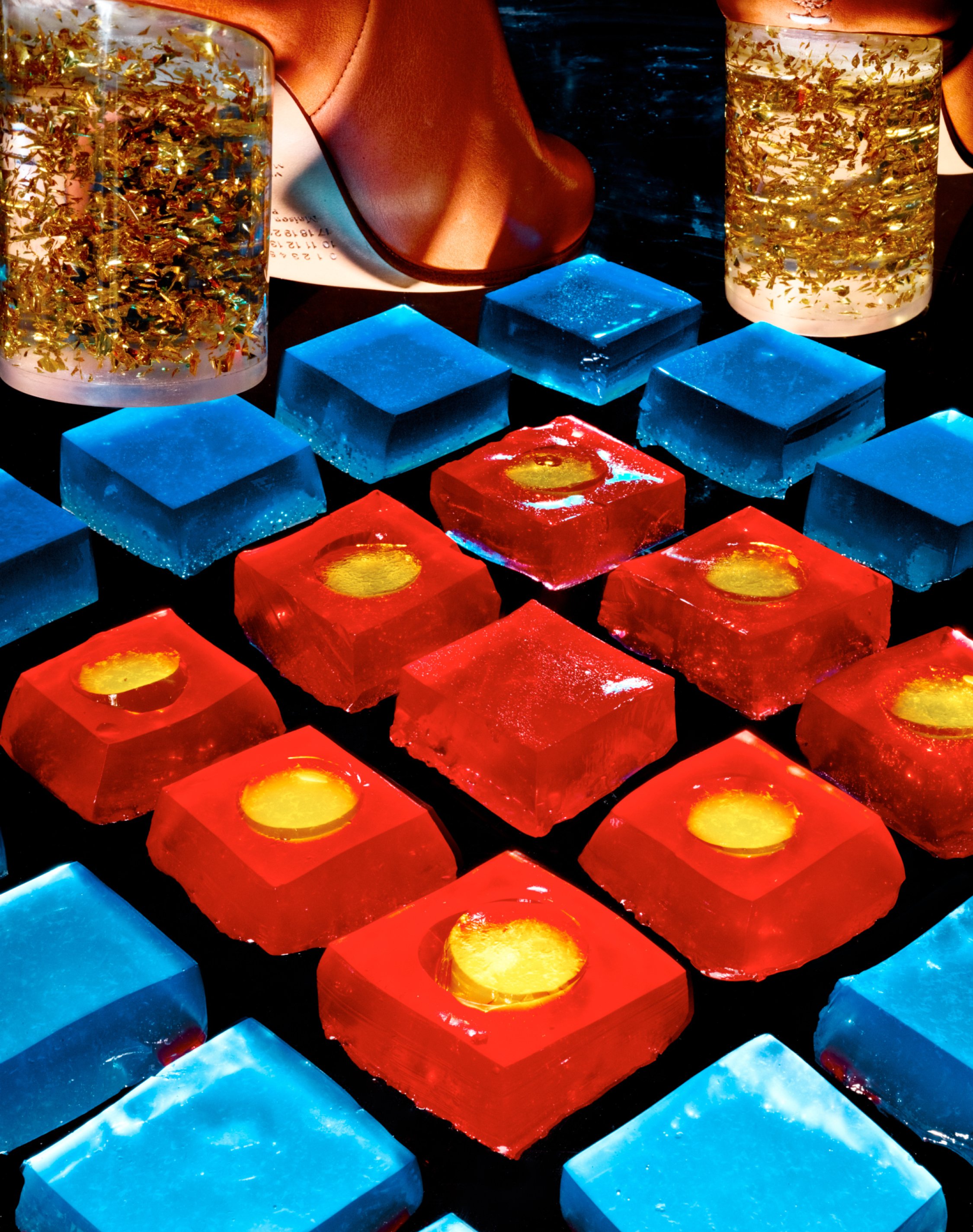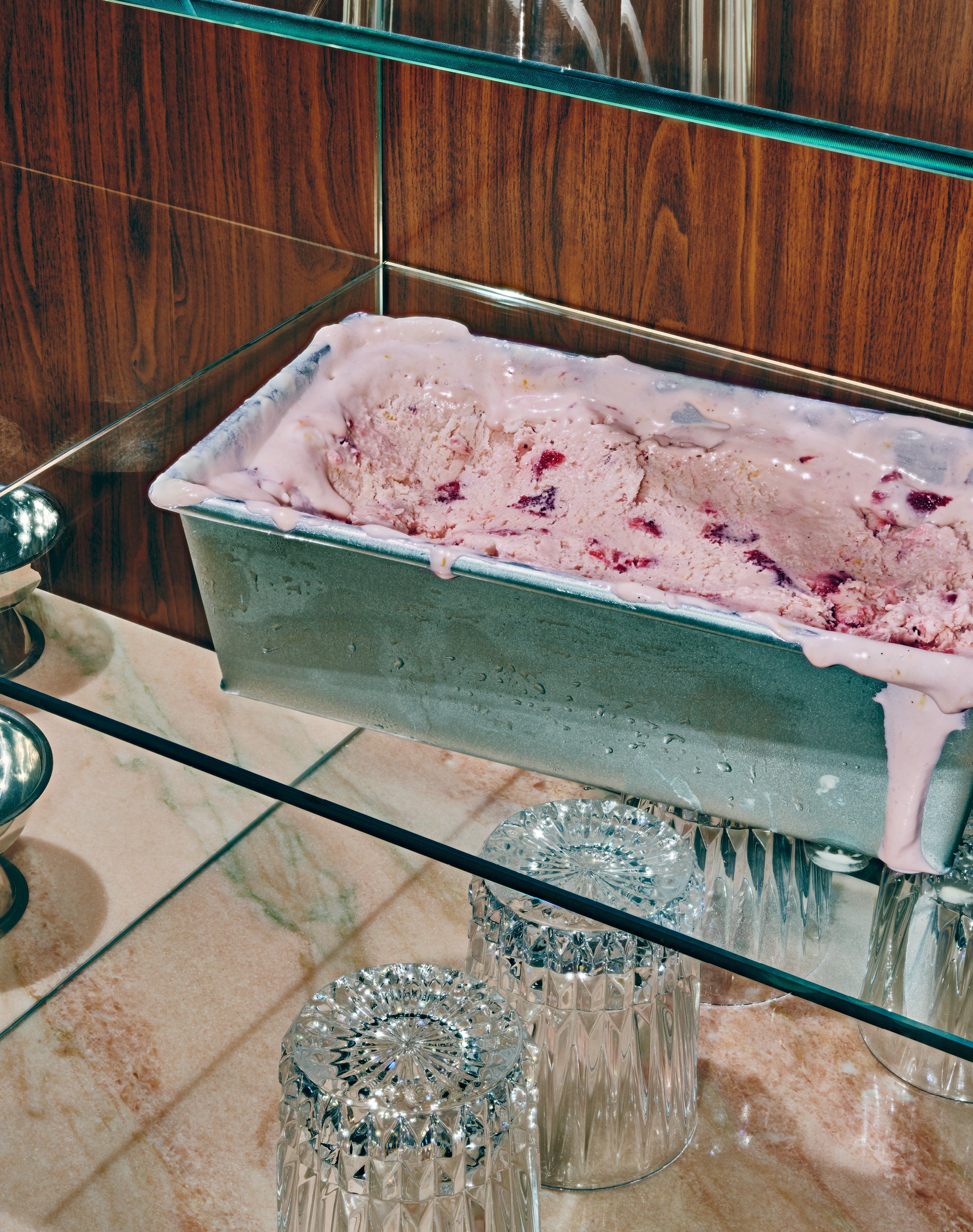The Artist as Entrepreneur
A conversation with designer Michele Outland (Apple, Bon Appétit, MSLO, Domino, Nylon, more)
Michele Outland has spent her career at some really beautiful magazines. Beautiful ... because she made them that way. Her resume includes stops at Martha Stewart’s Everyday Food, Domino, Nylon, and Bon Appétit, as well as the magazine she created and launched with her good friend, Fiorella Valdesolo: Gather Journal.
Gather, which only published 13 issues, made a powerful impact on the magazine business. In its five-year run, it won a James Beard Award for visual storytelling, an Art Director’s Club Award, and twenty medals from the Society of Publication Designers, including being named “Brand of the Year” in 2015.
Under her leadership, Bon Appétit won the ASME National Magazine Award for Design along with a slew of SPD awards.
We talked to Michele about the power of internships, her Korean mother’s influence on the way she thinks about food, about how to start a magazine in a post-print world—and when we can expect the return of Gather Journal, the strong female role models who shaped her career, and, of course, pizza.
Premiere issue of Gather Journal, Summer 2012.
Debra Bishop: Let’s talk about young Michele. Where did you grow up?
Michele Outland: Well, I was born in Lubbock, Texas. So my father’s side of the family is very much from the Texas/Oklahoma area. But when I was six months old, we moved to Colorado, where I grew up until I was 18. You know, moving around Colorado here and there, but mainly Golden, Colorado, is where I spent my formative years. The claim to fame is Coors Beer. I loved growing up there. The mountains are beautiful and all that sort of stuff. It’s a very outdoor lifestyle.
Patrick Mitchell: What did your parents do?
Michele Outland: My dad is an architect, so he was in Lubbock going to Texas Tech. He studied architecture there. My mother’s Korean. They actually met in Korea when my father was an engineer in the Army. But my whole life, as far as I can remember, my dad had his own architecture firm. I was thinking back on it in terms of how it’s influenced my career. I think both my parents are very entrepreneurial people. My dad has had his own architecture firm my whole life. He’s retired now, but the firm is still in existence.
I think both of them have been great role models for me in terms of having somewhat of an entrepreneurial spirit but also a hardworking ethos. My mom has done a variety of things. She started her own fashion clothing business that produced silk garments out of Korea. She’s run other businesses as well. They’ve always been very enterprising and entrepreneurial which I think has been a big influence on me.
Patrick Mitchell: And as we’ll find out soon, so were you.
Debra Bishop: Growing up, what was your first memory of design? When did you start thinking it was something you might want to pursue?
Michele Outland: I’ve been into the arts since a very young age. Art class was always my favorite class in school. I think my parents definitely recognized that. They very kindly invested in me going to art camps during the summertime. That was hugely influential to me. As I got older and knew that perhaps a career in the arts was something I really wanted to pursue, my dad who is in the business was like okay, let’s really think about what you like about the arts. Like what part of the arts are we talking about here? That’s when I was in high school, and I kind of didn’t know. He was like, “Well, look. My office space is shared with a graphic designer. Why don’t you go over and speak to her and learn about what she does a little bit?”
I went over and met this woman, Christina Weber. I sort of credit her for my whole career. She changed the course of my life. We’re still in contact, and she’s just a wonderful person. She had a design studio in Denver, mostly specializing in print collateral and branding. She gave me my first internship when I was 16. I just literally had no idea what graphic design was, but I spent the whole summer there. It really sort of changed the course of my life.
Patrick Mitchell: That’s amazing. Were there magazines in the house when you were a kid?
Michele Outland: Yeah, there always were.
Patrick Mitchell: Did any in particular catch your eye?
Michele Outland: My dad always had Architectural Digest around, being an architect. But Time magazine was always in the house. I remember my grandparents—I think a lot of people of that generation had National Geographic around. So I definitely remember those. As far as the magazine that was hugely influential to me, it was when I went to start my internship at Weber Design. It was my first day.
I was kind of sitting in the back room just not knowing what to do, and Chris brought over a book by Neville Brody. She was like, “I want you to just sit and look through this.” And I was like, “What is The Face magazine?” Like, what? You can design typography? That really just shot me into a whole other direction. I really became obsessed with The Face. That whole genre just really took me in a whole other direction.
Patrick Mitchell: Were you able to find copies of The Face in Denver?
Michele Outland: At the time, no. But once I went to college, it definitely became a regular purchase that I would splurge for.
Patrick Mitchell: Where did you go to college?
Michele Outland: I was very excited to be accepted to the Rhode Island School of Design, so that was my first time away from Colorado. I made the big move to Providence, Rhode Island. I ultimately became a major in graphic design at RISD. I was thankful. At that time, I had interned for Chris for three summers. I think I interned for her between freshman and sophomore year. Then I did every summer and even the summer right before I went to college. I even actually think I did it maybe one summer after I came back from college.
Patrick Mitchell: That’s an early start—high school interns!
Michele Outland: Yeah, it was. And I was just again very thankful that by the time I got to college, I knew what I wanted to do. I made my experience very valuable because I knew what to focus on very quickly.
Patrick Mitchell: When you were at RISD, did you do internships there too?
Michele Outland: Yeah, so again, I think I interned for Chris one more summer maybe between my freshman and sophomore year of college. Then I think they were encouraging us to find internships while I was in college. So I found this company in Boston called Moore Moskowitz Design. I started interning for them during the summertime in college. That was a husband-wife team, Jan Moskowitz and Tim Moore. It was quite a small studio. Most of the time, it was just them. And again, it was hugely influential in my career. I learned so much about typesetting from Jan. She’s an incredible typographer and typesetter. They did a lot of work—sort of print collateral—for the colleges there in Boston.
I had some great opportunities to work on some of the college catalogs. That really led me into my love of this sort of editorial type of design in terms of concepting, choosing fonts. And oftentimes, with those college catalogs, you are just given photography from the school and you need to make it look cool. So they had a lot of clients that just didn't have a lot of budgets. But Jan really is so creative in mixing paper stocks or even if the budget was limited with two colors, how to make two-color printing look really exciting. That was a lot of the stuff that I started on with them. Again, it really was so formative for me.
Patrick Mitchell: Did you stay with them throughout your time at RISD? Or did you do other internships?
Michele Outland: I did. I interned for them for a couple summers, two or three. Then I was very excited when they hired me straight out of school. So after RISD, I went to work for them.
Patrick Mitchell: So that was your first job out of RISD?
Michele Outland: I went to Boston and started working for them. But as is with the design business, they were a very small studio, just the two of them. At that point, I think we were like working out of their house. I would commute to Brookline and work in a room in their house. It was great. I loved it. But it wasn’t, at a certain point, sustainable for them. You know, business is hard. So they had to let me go at a certain point.
I started working with another design studio in Boston called Eimer Design. And another husband-wife, Doug and Selena Eimer. They were also so wonderful, and I learned a lot there too. A lot of the clients were print-based. They did a lot of annual reports. So I worked on quite a few annual reports with them and again, really hammered home that sort of somewhat editorial but like print typesetting in a catalog format type of scenario. I learned just a lot about type-setting, printing, paper and working with a client. Things like that.
A sampling of Outland’s work for Martha Stewart Living Omnimedia
Debra Bishop: How did you get started in magazines?
Michele Outland: At that point, I’d been in Boston a couple years and most of my friends from RISD had moved to New York City. I was sort of itching to move to New York. But also, when I was working for Jan and Tim, Tim was British. He used to be an instructor in England. That's how Jan met Tim. They taught me a bit about British design. I was always like, “Ah, I want to go check out London.” And they were like, “Oh, we have some family friends. You could go live with them and be a nanny for their kids.” And I was like, “Okay!”
I was in my 20s and so I went to be an au pair. But right before I left, I came to New York and tried to have a bunch of interviews. I dropped off my resume wherever I could and nothing was sticking. So I was like, all right, let's just go to London. I’m in my 20s, you know. Why not? So I went to London and was an au pair for two wonderful kids. I'm still in touch with the family. And I tried to get a little bit of design work and went clubbing and really enjoyed London.
Patrick Mitchell: Did I see something about Central Saint Martins in your resume?
Michele Outland: Yeah, so while I was there I definitely learned about Royal College and Central Saint Martins. I just kind of really tried to take in the design scene and ethos in England, which I think is incredible. I love the level of design there.
Patrick Mitchell: Did you go to Neville Brody’s house (laughs)?
Michele Outland: I didn’t stalk him to that extent but pretty close. (Laughs). I think I tracked down his studio. But while I was there, somehow my resume had gotten passed on to Martha Stewart Living. One of the art directors, James Dunlinson—he’s British—happened to be in London. He was back home visiting his family and got in touch with me and was like, “Oh, I’m in London. Could you interview?” And I was like, “Okay.” (Laughs.)
So I met him in London, and we sat down for an interview. I was like, “Okay, I have never done magazines. I don’t understand what you do. Could you tell me a little bit about it?” And James is an incredible art director. So he was very gracious and explained a little bit about how the process works there. I was like, “Wow, that sounds really cool.”
Amazingly they offered to hire me after that interview. That helped bring me back to the States. I mean, I had to leave the country anyways. They didn’t want me there anyway. (Laughs.) It was great. It was perfect timing. That helped me move to New York. And my first first job in magazines was at Martha Stewart Living.
Patrick Mitchell: So in addition to the creative titles you’ve had, you added “founder.” That’s pretty special. Talk about how Gather Journal got started.
Michele Outland: So I had gone through a series of working at various magazines, from Martha Stewart to various publications within that, to Domino, which was another big title from Condé Nast. Then I got an opportunity to work at Nylon as their art director. It was the complete opposite world of both of those, you know. Martha and the Condé title had pretty decent budgets. Very corporate. And Nylon was this cool downtown magazine—independent. But a decent budget. It had always been a title that was influential to me as a designer.
The editor-in-chief Marvin Scott Jarrett founded Ray Gun. And then obviously David Carson was his controversial art director but hugely influential in the design world. So I really wanted to have the opportunity to work with Marvin. It was very different from the path that I was on in terms of this bigger, corporate path. So I took a huge pay cut and went to work at this downtown magazine. It was a wild time, really. Every month you were like, “That was a miracle that the magazine came out.” (Laughs.) Because it was a bunch of 20- and 30-somethings.
I think Marvin has a really — and I’ve learned this from like a lot of people in my career, especially Martha as well. You know, a great way to run a place is to surround yourself with really great people and let them do the best that they do. To a great extent, that's how Nylon was run as well. We were really left to do our jobs. It wasn’t you know, “You need to be here at this time…” but it was just like, “you need to make sure the magazine goes to the press at the end of the month,” kind of thing. Do whatever you have to do.
It really was this new experience. It was an extremely small staff. I had been used to these staffs that had full art departments, full production departments, full photo departments, etc. Suddenly it was an art department of me and one other designer. We had to interface with advertisers, get their advertising files in and explain to them how the file needed to be. It was like a whole other level from beginning to end of designing a full magazine, color-correcting it yourself. We did have a production house, but you had to mark up all the color and proof every single page, including ad pages, and get a magazine out every month.
I learned so much. It was wild and crazy, but it was such a wonderful time and I learned a lot. After leaving that job—which might show a consistent thread in my career, really—at the end of it, I burned out. It was time to go.
So when I left, I took some time. Quite honestly, I was baking a lot of bread. (Laughs.) This was way before the pandemic before everyone was baking bread. And while I was baking bread, this food magazine came into my head. I knew Fiorella [Valdesolo] from Nylon. She was the beauty editor there, also the deputy editor, as well. We were great friends and one big thread between our friendship is that we love food. We both have immigrant parents, and I think food has been a really big part of holding onto our culture, learning about our culture through our families. And then also we just eat out all the time and talk about food all the time. So we had this common interest, but I think also beyond that the fun thing about Nylon was that it was a fashion, beauty, culture magazine. These were all topics that really greatly interested us. So we were like, how do we take what we learned from Nylon and put that into another format?
So we kind of developed this idea of this food magazine that was a little unconventional and covered art and culture as well. But at the end of the day, I also brought a lot of what I learned at Martha and wanted people to really cook from it. So that was why we set it up as a recipe-style magazine but with a lot of layers on it. You know visual layers, editorial layers, etc.
Patrick Mitchell: How did you pay for it?
Michele Outland: Our own money. So we had some savings, and we went in 50/50. With the money that we had, which was very little (laughs), we printed 1,000 copies. That was our first issue. We were like, “we hope our parents buy some copies” (laughs) and then asking a lot of friends.
Patrick Mitchell: Were your contributors working for free?
Michele Outland: We paid everyone very small amounts of money, but we did pay people. It really was just asking for favors, like gigantic favors that all of our contributors were offering. It really was like all of our friends. I was asking all of my photographer friends. Fi was asking all of her writing friends. That’s how it started.
Luckily, our first issue of 1,000 copies sold out. So we had enough funding to do another small reprint of that, and then that sold out. And then we were like, oh okay, maybe we can keep this going. We had no business plan. It was terrible [laughs]. For both myself and Fiorella, I think we have this true love of art and creativity and that was really why we started Gather. It was not to make money. I also want to point out that magazines will not make you rich [laughs].
Patrick Mitchell: How did you get it out in the world?
Michele Outland: Grassroots. I lived on 12th Street and I walked down to Casa Magazines. I love that they’re getting a lot of press right now, But I’ve known them for all the years that I’ve lived in the West Village. I was like, “Would you maybe sell my magazine?” And they were our first stockists. I literally walked it down to them and asked if they would sell. So it was very grassroots of us just like walking in the stores and being like, “We have this thing. Can you maybe sell it?”
Patrick Mitchell: You were selling it internationally too, weren’t you?
Michele Outland: Yeah. Again, it was just so incredible and so thankfully that the first issue was so well received and got quite a bit of press. The power of press is pretty impressive. The word got out. And thankfully from there, we really didn't have to market the magazine. We were able to just—everything was people getting in touch with us.
Patrick Mitchell: For our listeners who maybe haven't seen it, it's really, genuinely one of the most beautiful magazines ever.
Michele Outland: Thank you.
Patrick Mitchell: So it’s a little bit on hiatus now, right?
Michele Outland: Yes, so we published for six years and we produced 13 issues. We did two issues a year. At the tail end of it, things just in our lives started happening. Fiorella had a child and motherhood. I took on a rather large position at Bon Appétit. So it was just, you know, for the way we sustained producing Gather was through freelance work. Gather was not our full-time job by any means.
We shot issues of Gather on the weekends and in the meantime, we freelanced. So I have a big freelance career working all over the city here. I’m thankful to the city for that. That’s how we were able to sustain and produce Gather, by having these freelance jobs and doing Gather as a real passion project. It was 100% a passion project and then just when these other bigger life things happened, our passion just got tired. So we just couldn’t physically do it.
Debra Bishop: It’s a lot of extra work.
Michele Outland: Yeah, it’s a lot. But, you know, again, every time an issue came back from the printer it was just so thrilling. So it's something we'd love to return to if we can.
Debra Bishop: What’s your favorite thing about magazine making? And your least favorite?
Michele Outland: [Laughs]. It’s funny because I’m teaching a food photography class this semester at ArtCenter in Pasadena. So I’m working with all these young, budding photographers, all very talented and trying to introduce it. Obviously it’s sort of odd that I’m not a photographer teaching a photography class. But hopefully what I'm bringing to the classes is showing them how our commercial world works.
The main thing that I’ve tried to impress upon them is how collaborative our business is. Even from a photo shoot to a magazine, it’s incredible how many people it takes to put it together. It is not a one-man show by any means. That’s something that I’m really trying to impress upon them and anyone else who’s listening. I do think that a big part of this industry that I love is interacting with people and working as a team. For example, the relationship between me and Fiorella. I think she’s a genius editor. She’s a genius writer and when we came together to form Gather, I knew that she was the best at what she does. She knew I was best at what I do. We were like, you handle words, you handle visuals and we really left it to each other. We very rarely would stray over. But we would, if we needed to. We absolutely could say it. There was a lot of trust.
Debra Bishop: There was mutual respect and trust.
Michele Outland: Yeah, yeah.
Debra Bishop: Talk about your best relationships with editors. Obviously, that was a special relationship you had with Fiorella.
Michele Outland: For us people in the art department [laughs], I think really the memorable working relationships with editors typically comes from an editor who’s really visually-minded. Our job is to translate the editorial content that is brought forth to us, if not, you know, collaboratively and collaboratively developed with them. We then translate it into the visual.
We have to be able to articulate our feedback on their content and it certainly helps when they can articulate feedback on our content as well. So the more it can be sort of a two-way conversation, I think that’s what makes the memorable working relationships. And it obviously makes, you know, the strongest content. Ultimately, all of our goals are how do we take these worlds of written and visual and translate that into this one cohesive piece that is engaging and moving. Ideally I think, for me, it really comes down to communication.
Debra Bishop: Pretty much you’ve been working on food and fashion. What is it about those areas that attracted you?
Michele Outland: Yeah. I think about food—you know, I’ve been working in food for so long now. I love the visuals of food. I think oftentimes, before we actually have that experience of taste, we have sight and smell. So I love figuring out a transformative visual for food or a visual that helps explain what that food is about to taste like. So there’s that visual.
Then obviously, I think fashion is not too far from that in terms of something that excites the eye and can be very transformative to someone who wears it. But I’m clearly very obsessed with the visual of food. And certainly the direction that I took Gather’s visual is because I had been certainly very well trained in the world of Martha. I’m so, so thankful for all the training that I learned there, which was much more sort of a naturally-lit type of food photography style. I think she was hugely influential, Gael Towey especially helped drive that visual at the time in terms of when the magazine was founded in 1990. I think they were huge in that development of photography. I learned a lot from it, and I’m so thankful for that.
I think at the time we founded Gather I wanted to try and look at food in a slightly more cinematic sort of way. Because I love the experience of being in a restaurant or at a dining table and how the lighting and the color of the room and this and that really sort of transforms that experience. So I was trying really with the visuals of Gather to get more atmospheric and transportative.
“As a young kid, you’re just like, ‘Oh, I have fonts. Let’s design and go crazy.’ When you really sit down and look at magazines, they are built on systems. They have to be built on systems because they have to come out every single month, and you can’t reinvent the wheel every single month. So to a certain extent, there should be a system there. ”
Debra Bishop: You’ve been involved in a lot of startups and redesigns. You’ve created a look and feel for some pretty legendary brands: Everyday Food, Martha Stewart, Domino, and of course, Gather. How do you think about creating design systems for big brands and starting them from scratch?
Michele Outland: I clearly enjoy it. I’ve been so honored to be brought in on those initial teams. I think it goes back to that entrepreneurial spirit from my family that I just love getting in on the get-go. It’s been really you know, especially with the experience of Everyday Food and Domino, there were very specific briefs walking into that. Everyday Food was a small, digest-size magazine. Martha—she had a lot of input and I learned a lot from her in terms of how she would walk up to a wall and interpret a page and interpret a recipe. It was great. I learned so much.
Debra Bishop: She has incredible vision.
Michele Outland: Yeah, yeah. If you just try to think about everything that she’s managing and has in her empire and then can really just hone in on something—it’s fantastic. Really, really influential. And then with Domino, it also had a really cool brief. They had other shopping magazines at Condé at the time, which were Lucky and Cargo. So they wanted to start an interiors magazine, shopping-based.
But the brief was to design this magazine that was like your best girlfriend giving you decorating advice. It was such a strong visual brief that you’re like, alright, I know who this girl is. Let’s figure out the visual for that. So I’ve been fortunate that they’ve been really fun sort of briefs from the get-go. It is kind of fun to be there at the inception and think about sort of what the personality of that title can become. And then certainly with Gather.
Patrick Mitchell: How technical do you get in terms of the nitty-gritty in InDesign and the templates and the columns, all that stuff? Are you sketch-and-handoff, or do you do it yourself?
Michele Outland: At the time, especially with Martha, I was very technical. And again, I am so thankful that I got that experience. I learned so much. Gael Towey was hugely influential and really taught me about setting columns and grids and templates and systems before just getting carried away with, like, “Let’s just design!” You know? As a young kid, you’re just like, “Oh, I have fonts. Let’s design and go crazy.” When you really sit down and look at magazines, they are built on systems. They have to be built on systems because they have to come out every single month, and you can't reinvent the wheel every single month. So to a certain extent, there should be a system there. You can’t say you can’t break that every once in a while. But again I’m very thankful that I had that training in the beginning. I was very involved at the time with Martha and did a lot of special issues for them and books. So I was very much part of choosing fonts and building templates and all that sort of stuff. Further into my career, now I’m not.
Debra Bishop: How has it been working in a fairly male-dominated business for all these years? Have you felt stereotyped at all to women’s content?
Michele Outland: A tiny bit, But also at the same time, I have felt that I’ve had incredible female role models. I’m so thankful for that. Again, it starts from the very beginning with Chris Weber giving me my first internship to Jan Moskowitz to Martha, to you, Deb—I’m so thankful that I learned so much from you. Throughout my career, I’ve had incredible female role models.
But yeah, I do feel like it is hard not to say that a lot of the field is male-dominated and certainly women typically work on women’s titles. You know, it’s very funny. We had this meeting when we were doing Gather. We met this store owner from Japan and it was this very formal meeting. It was very interesting. We were brought into the room and business cards were exchanged and then we all sat down. It’s just this very big ceremony, kind of. And then like the first thing he said was like, “Hmm, I thought Gather was done by men.” I was like, I’m not sure how to react to that. But I might take that as a compliment [laughs].
Spreads from Bon Appétit
Debra Bishop: Was there a certain area of content or a certain kind of magazine that you might have wanted to work on, or still might? One that’s not typically, you know, female content?
Michele Outland: I mean, I think maybe Gather is the closest that we’ve gotten. I don’t think we made it look like a typical sort of women’s title. I think in some ways, maybe it’s kind of androgynous which interests me. If anything, we’d like to keep expanding what Gather is in terms of food and art and storytelling.
Patrick Mitchell: Launch a grilling magazine for men? (Laughs.)
Michele Outland: Yeah, exactly. I mean sure. Why not? (Laughs.)
Debra Bishop: I like that idea.
Patrick Mitchell: I think there’s a British magazine for grilling. It’s called Pit. Have you seen that, Michele?
Michele Outland: Oh yeah, yeah.
Debra Bishop: We need to go further than that, though. It needs to be makeup for men.
Michele Outland: Yeah.
Patrick Mitchell: Exfoliating.
Michele Outland: Yes [laughs].
Debra Bishop: You gotta flip it.
Patrick Mitchell: In my research, I saw some photos and I just have to ask. Where did you get that big-ass couch in your Condé office? It looks like it seats 10 people.
Michele Outland: Well, it was gigantic [laughs]. The photo trick is that it was not my office. That was the corner in the art department. So all the designers used to sit next to that big couch. So they had nice windows, and I was in an office inside. Sadly, it made it look quite luxurious. But not reality. Don’t believe everything you see on the internet.
Patrick Mitchell: I’m gonna guess that you didn’t get to keep it when you left.
Michele Outland: No, sadly. I would have no room to put it [laughs]. But yeah, that was a good couch.
“I think any working relationship with any creative director with their editor-in-chief is a new relationship where you work together to achieve a goal. It was good. I think I had clear briefs with both editors and didn’t disagree with the briefs. I enjoyed working with both of them.”
Patrick Mitchell: So you just spent a multi-year run at Bon Appétit doing some of the best work out there. The best design work. The best photography work in the magazine business for quite a little run. That ended this past summer. What happened?
Michele Outland: To be completely honest, it was burnout. Again. Yet again. I just completely burned out. I just didn’t have any more gas in the tank. I wish I did, because to a large extent it was a job I really enjoyed. It was a huge, really different type of role that was unlike anything I’d done. I think it was a really big job—a job like I had never experienced before. But, to be frank and kind of going back to your question earlier, Deb, I was really proud that I got that position. I felt that all of my years of experience earned me that title. So I was really excited to join the team and ideally bring my experience in food to the title. And I think I did.
You know, it’s funny because when I got there, you see this in the magazine and industry a lot in terms of waves of staff changing. I think, again—I guess this will foreshadow why I left—people burn out. Waves of new teams come. When I came in, I was on the tail end of a wave of folks that had been leaving the title again from what I understand, burnout. So I had to build a brand new design team. I had a whole new staff from scratch. So I built a whole design staff and a photo team and within that couple years, was really proud that we turned out some award-winning work. But again it was ideally really finding some really great talented people and like letting them really do the best that they do. But, you know…
Debra Bishop: But it took its toll?
Michele Outland: Yeah.
Patrick Mitchell: The editor who hired you [Adam Rapoport] notoriously had to go in the middle of your run at Bon Appétit. Suddenly you find yourself working with a new editor. What was that like?
Michele Outland: You know, it was the reality of what happened.
Patrick Mitchell: Did the mission stay the same, or did the new editor bring a new perspective on the magazine?
Michele Outland: Certainly, and I think any person does. I think any working relationship with any creative director with their editor-in-chief is a new relationship where you work together to achieve a goal. It was good. I think I had clear briefs with both editors and didn’t disagree with the briefs. I enjoyed working with both of them. You know, it’s just the sort of reality of the business that things change and you need to be professional and do your work as professionally as possible. It was all a great experience. It was challenging for sure.
But again, still really proud of the work we did. Unfortunately, in the end it was just burnout. And again, it was that next wave. It’s funny because you kind of look at it and you kind of do see waves in the design industry that go every four years. Maybe it’s some sort of harkening back to college where you’re just like all right, time to switch. So it really was just like okay, the burnout is here. Here we go.
Debra Bishop: It was such a big job for somebody who is so creative and has been so hands-on in the past. How did you deal with the stress of that? Do you have a favorite swear word (laughs)?
Michele Outland: [Laughs] Unfortunately, I probably internalized it too much. I think most people that know me know that I’m a pretty quiet person. But yeah.
Debra Bishop: Yeah, I do. I know that you’re quiet. That’s why I’m wondering. How did you deal with it? I’m sure very calmly and with grace, as always, though it was a lot.
Michele Outland: A negroni in the evenings was a fantastic soother for lots of stress [laughs]. But I mean I think again, I loved the challenges that were really different. I wasn’t just working on a magazine. It was not my sole focus by any means. Part of my team was also a branded content team, a fully digital team. And so it was dealing with the scope of print, digital, branding, events. It was massive. And Instagram. You know, Instagram is something to talk about in the future of our business here. How much time and focus went to Instagram content. It was a lot and I learned a lot, as challenging as it was. It was great.
Debra Bishop: You had a huge team. So what was your strategy for building the team, restructuring, recreating a new team?
Michele Outland: I think as I mentioned before, it’s finding those key people that you know are so strong that they can lead as well. So I think having a really strong design director who was Chris Cristiano, a really strong visuals editor who is Michelle Heimerman, and just having incredible staff photographers and branded content art directors. Having those key people that help build that structure—I learned a lot in terms of I can’t do everything. I can’t be everywhere all the time. So I need to trust those people to handle X, Y and Z for me to review later. Again, I think the lack of micromanaging certainly helps give people confidence. I hope I instilled that, hopefully. They'll probably be like, you micromanage too much [laughs].
Patrick Mitchell: When you went to Bon App, did you hire people that you had worked with before from other places?
Michele Outland: No, everyone was brand new. A whole new set of folks, which was great. It was a wonderful experience. I think it just goes back to the fact that for 10 years before this, I freelanced. That was all I did. I went from place to place. I feel like that really helped me in my career and as a designer. Changing places, changing systems, learning new people really helped me grow. I know it's not the conventional career path and some people look at resumes and have red flags and so on and so forth. But Deb, you kind of just mentioned that I am sort of this creative spirit, and I think that sort of taps into my own personality.
A sampling of photography and spreads from the award-winning Gather Journal.
Patrick Mitchell: Speaking of food. There was a quote I saw that you said your Last Supper meal would be a slice of New York pizza. From where?
Michele Outland: 100%. It would be from my local in the West Village here. Village Pizza on 8th Avenue. Everyone check them out. They’re wonderful.
Patrick Mitchell: Are you familiar with a Palermo pizza?
Michele Outland: Yeah, I think so. Actually, I’m not sure. Maybe you should re-explain it to me.
Patrick Mitchell: Breadcrumbs and caramelized onions.
Michele Outland: Okay.
Debra Bishop: Sounds pretty good. I think we’re getting hungry.
Michele Outland: Yes [laughs].
Patrick Mitchell: My favorite slice is—do you know Ben’s? It’s on Spring Street and Thompson.
Michele Outland: Yes, Ben’s Pizza of SoHo. That would maybe be my very close runner-up. Love Ben’s pizza.
Patrick Mitchell: Usually, if I’ve driven to New York, I’ll spin by Ben’s. Just pull right up there and get a Palermo for the trip home. I highly recommend it.
Michele Outland: Nice. I always get a New York slice when I go in there, but I will get a Palermo next time. I’ll check out the recommendation.
“For both myself and Fiorella, we have this true love of art and creativity. And that was really why we started Gather. It was not to make money.”
Patrick Mitchell: So you and Bon App broke up. And at the time of this interview, we just got the news that several high profile, kind of legendary magazines were being shut down by the new company that owns Meredith. How are you feeling about the future of magazines and your future doing them?
Michele Outland: Yeah, it’s obviously extremely sad. I hate to see any print title go. I also know it impacts a lot of people in our industry. So I’m feeling very, very sad about that. But yeah, it’s maybe the million-dollar question in terms of where are we going in this industry? And it’s a really tough one. I’ve been thinking about it since I knew this was going to come up. But just thinking about how we consume content and the evolution—just where we are today and where we’re possibly going tomorrow. It’s obviously extremely digitally-based.
I know some of those titles might still be producing digital content. But it is really tough because there's something so different from editorial print design to digital design that I feel like the digital space hasn't captured that yet. I do feel like some of our—at least some of my thinking even when I was at BA was how do we translate our printed editorial experience into digital. I do think that The New York Times does an incredible job at their digital translations. It's exciting and I think that is a path forward to keep an eye on.
I do think somehow we need to keep pushing the digital experience. I know we tried it at one point, and I was part of it with Martha with the iPad experience. I imagine we’re going to be revisiting that again [laughs]. But also just how people are accessing it. There needs to be something that’s a little more streamlined somehow. It’s a tough question. I know it was mentioned when Gather was certainly in circulation of the influx of independently printed publications. We might be heading towards a place where when we do print, it’s specialty high-end printing possibly. You know, being a little more tailored when we print and how we print. Maybe the traditional convention of monthly mass market publications—I mean, unfortunately like what happened this week, it’s not something that the industry is sustaining.
Debra Bishop: Do you think that there would be a way to create Gather Journal, for instance, only digitally? Could you share how you might want to do that in a creative, innovative way?
Michele Outland: Possibly. We did a recipe app for Gather that was probably the closest translation that we did. The app, unfortunately, is no longer available. But we still offer our recipes online. So those are fully accessible with the photographs that we created for it. The biggest part of the creation of Gather are the recipes and the visuals. That’s the biggest part of the budget minus the printing costs.
So yeah, I mean that being said, thinking out loud here—I’m like, “Oh wait. Maybe we could do it and not spend all of our money on printing.” Unfortunately again, that’s the thing. I’m just like, I’m not sure if Gather would be as impactful in a digital space. I would be sad not to see those images printed on the paper that we found and printed on and really researched and worked with the printer on how to replicate the type of imagery that we produced on that kind of paper. There was like this really big love of craft that went into that.
That makes me sad, but I’m also like I don’t know if people care. I don't even know if they would notice the difference, but I did.
Patrick Mitchell: You said in a Folio interview, “there’s something about holding a magazine that’s very captive in a way. Digitally, I just feel like we’re exposed to so much content.” Which leads me to the next question. It’s sort of the foundational question for this podcast. Where can a great magazine maker take these unique format specific skills? Magazines were the product of editors, designers, photographers, illustrators, writers all combining their skills to make these beautiful objects and on a schedule. They had a life and an ongoing relationship with their audiences. There’s really just nothing else like them. Where can these skills be applied now?
Michele Outland: Yeah I was, again, thinking about that question and trying to distill it down to its core in terms of, what is it that we’re all passionate about that we stay in this industry and keep doing [laughs]? It’s not an easy industry to be in. I’m sort of thinking about what we were consuming content-wise during the pandemic, but I think at the end of the day we're all interested in storytelling. I’m sort of curious about how we can keep telling those stories and in what format.
Obviously, streaming services took off during the pandemic and binge-watching TV shows. We couldn’t consume them fast enough. But part of me, again, the lover of arts and culture, I’m sort of thrilled by it in terms of the fact that we as a society still love at its essence storytelling. Sometimes the storytelling helps us translate what we’re processing in the real world, which is a lot recently.
So I’m hopeful that there are still places for us to tell our stories and work with teams of people to tell the stories. That being said, maybe I’m going to go off and make a tv show [laughs]. I don’t know. Going back to ‘do magazines still have a place in all of this,’ I think they do. I think they’ll just be a little more specialized. I don’t want to say the word ‘thoughtful’ but I don’t know. I don’t know if you know what I mean.
Patrick Mitchell: No, I think you’re right. I mean you could look back now and say magazines have been so incredibly underpriced for decades for what you’re getting. Back then, you could get a one-year subscription to Esquire for $7. But those are the old days’ mistakes.
Michele Outland: Yeah.
Debra Bishop: Among other things, you’re currently freelancing at Apple. The other day, we were talking to a creative director who said, “For the amount of creative firepower Apple has scooped up from the magazine business, the end result—at least in the Apple News—doesn’t really show it.” What’s everybody working on in there?
Michele Outland: [Laughs]. Well, the tricky thing with Apple is that we are not allowed to talk about it at all. So we sign really huge NDAs. So, I unfortunately can’t speak about it at all.
Patrick Mitchell: Can you talk about what you’re working on?
Michele Outland: Unfortunately, no. But I do think what I would like to say is that I’m interested in this sort of next phase of not being in the editorial world. I’ve been in the editorial world for so long. Suddenly I’m not on this cycle of, I have to produce an issue every month and you know, however many digital content pieces. And this and that.
Again, I think it sort of goes back to maybe even where my career started in a way of having to translate just information into visuals. I’m very intrigued by it in terms of suddenly being in a different space and format to produce content. So, I don’t know. It's an interesting next phase. And I know Apple is notorious for scooping up the editorial world. And so yeah, I’m very curious about it.
Debra Bishop: Famous last words [laughs].
Patrick Mitchell: I can tell you from my own experience, there’s nothing like working for yourself. Do you have any plans to produce Gather again? And if so, what would that look like as a business?
Michele Outland: Yeah, I think we would love to. And I agree with you. Working for yourself is so thrilling. I mean again, every single issue of Gather was so rewarding. It was thrilling to get that first box of printed issues and tear it open and look with one eye because we were afraid of typos and mistakes and everything. But still, very thrilling. We would love to do it. I think we are older and maybe a little wiser now. But I think for us to be able to do it I think quite honestly and just frankly, we would need some money.
Patrick Mitchell: I can’t imagine you haven’t been approached by a publisher.
Michele Outland: We haven’t! [Laughs]. So for anyone who’s listening out there [laughs]! No, we never were.
Debra Bishop: Dotdash will be calling you.
Michele Outland: We would love a silent partner. That would be the dream. But yeah, that was also how we could have full creative control and feel really satisfied by it by the end of the day. But like we said, it took 100% of blood sweat, tears, passion—all that sort of stuff. working nights, weekends. I just don't know if we just have that stamina in us at this point anymore. But you know, creatively we would love to do it. But I do think the business model needs to look considerably different.
For more information, visit micheleoutland.com




